What Is Google PageSpeed Insights?
Google’s PageSpeed Insights (PSI) is a free device that analyzes the efficiency of your webpages on cellular and desktop gadgets. And gives beneficial metrics (often called the Core Net Vitals) to evaluate the standard of the person expertise.
The device offers you a rating between 0 and 100. A better rating normally means your web page is optimized for pace and effectivity.
PSI makes use of Lighthouse (an open-source, automated device) to research webpages’ efficiency and high quality. And offers a efficiency report with enchancment recommendations based mostly on two sorts of knowledge:
- Lab knowledge: That is knowledge collected by Lighthouse in a managed surroundings. It helps you debug points by simulating how your web site hundreds however may not present real-world person expertise points.
- Discipline knowledge: That is real-world person expertise knowledge gathered from precise customers as they work together together with your web site. It offers a practical view of the person expertise however contains fewer metrics.
What Is a Good PageSpeed Insights Rating?
A rating of 90 or above is nice, 50 to 89 wants enchancment, and beneath 50 is taken into account poor, according to Google.
In case your rating is beneath 90 throughout many pages, it’s doable your customers aren’t having an excellent expertise. And there could also be some damaging website positioning results as effectively.
However there’s no level in obsessing over an ideal rating of 100—particularly on each web page. As a result of guests finally care about shortly discovering data (or an answer). Not your rating.
How Does Your PageSpeed Insights Rating Have an effect on website positioning?
Google isn’t working your web site via PSI and utilizing it to rank you. However that rating is partially based mostly on page speed—a confirmed Google ranking factor.
Sluggish loading occasions frustrate customers and make them abandon your web site. However guests usually tend to keep and interact together with your web site if pages load shortly.
This results in a greater person expertise. And search engines like google reward websites that present an amazing page experience to guests.
So, enhancing your PSI rating is prone to have a optimistic influence in your search rankings.
Easy methods to Use the Google PageSpeed Insights Instrument
PageSpeed Insights is fairly simple to make use of.
Simply go to PageSpeed Insights, enter any URL (whether or not it’s your personal or a competitor’s), and click on “Analyze.”
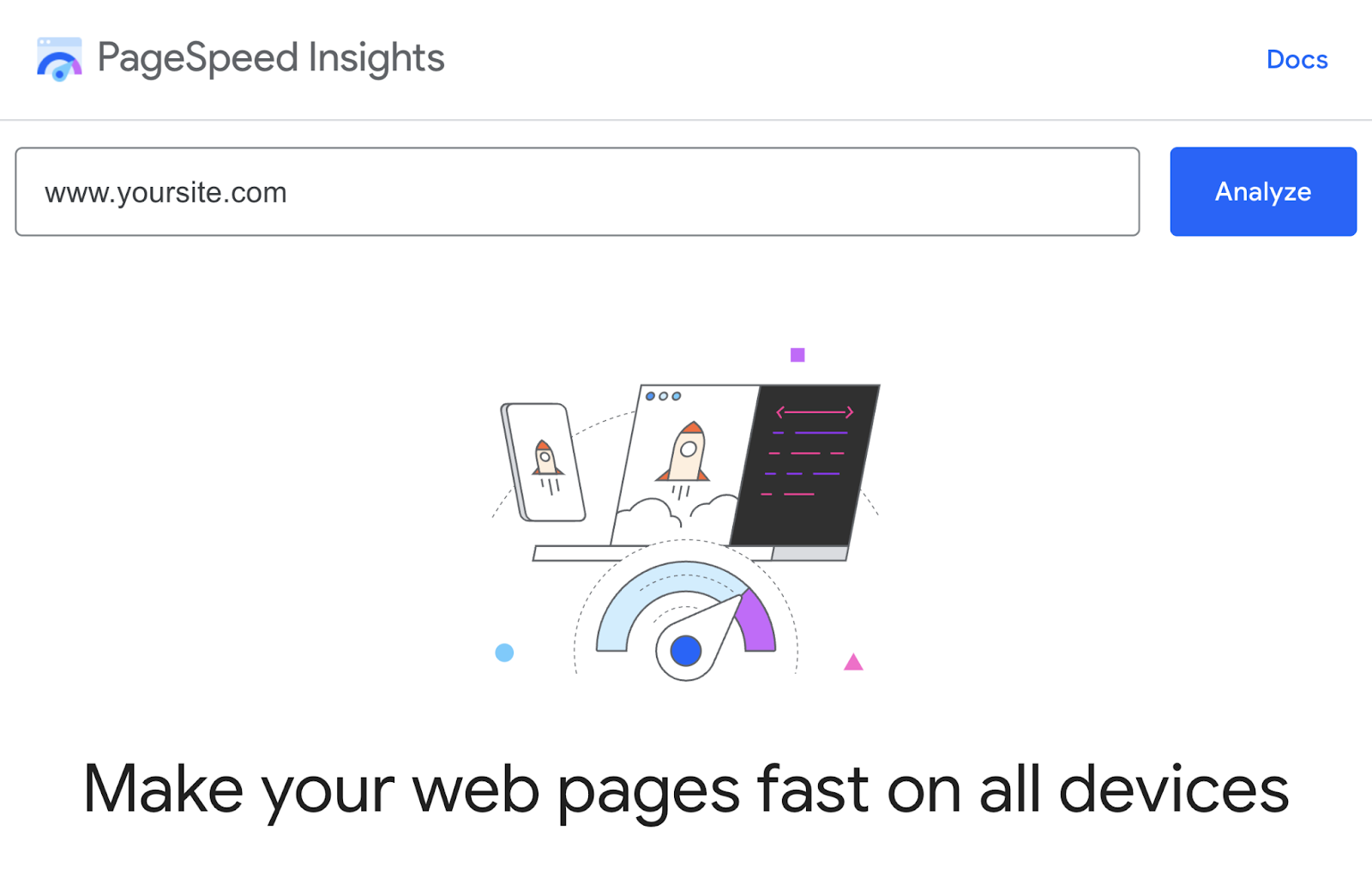
Then, look ahead to the device to research the webpage. This may increasingly take a number of seconds to a minute, relying on the complexity of the web page and your web connection pace.
On the prime of the report, you’ll see whether or not your web site handed or failed the Core Net Vitals Evaluation. Like this:
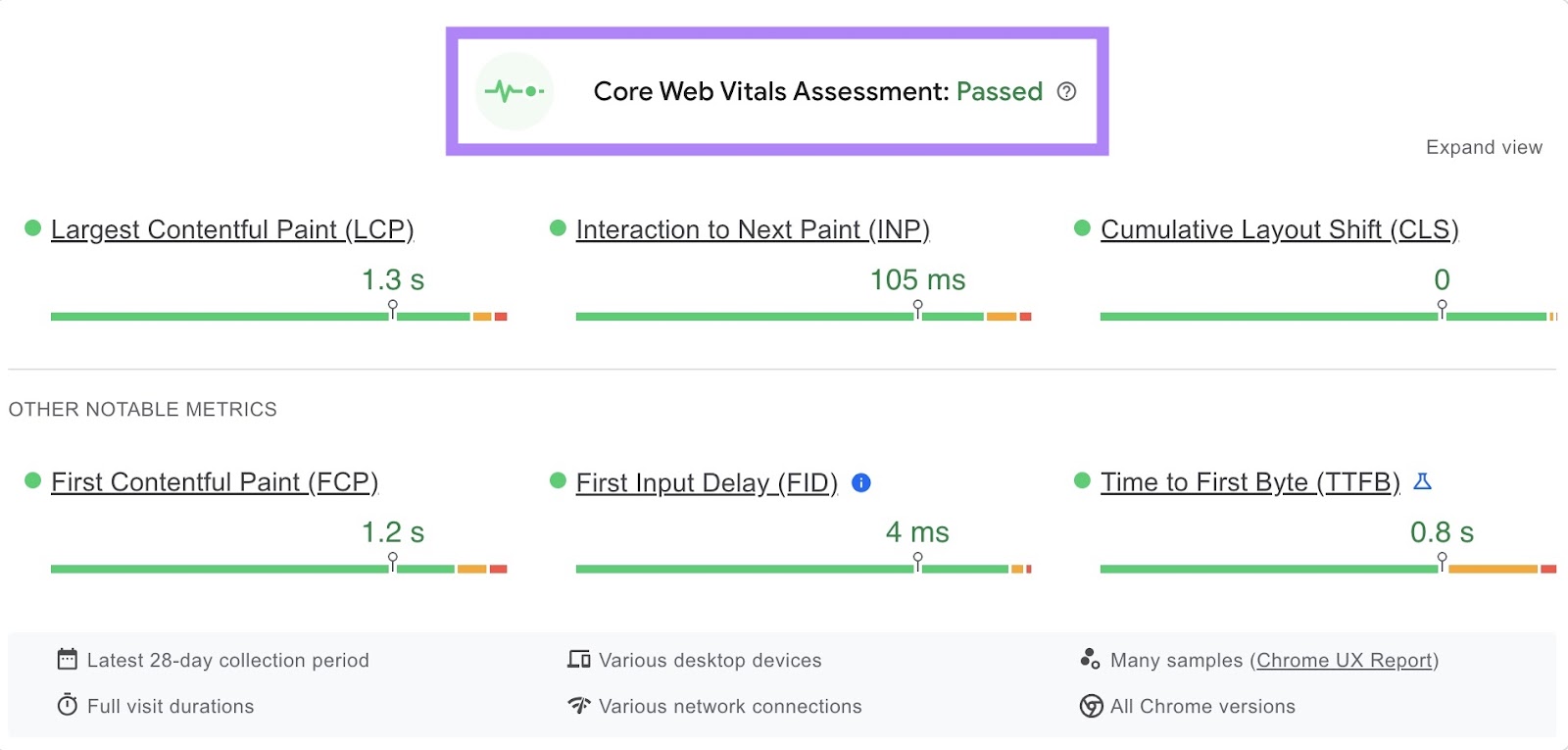
The Core Web Vitals are a bunch of metrics that measure an internet site’s (or a web page’s) user-friendliness. Primarily based on load occasions, interactivity, and visible stability.
It contains these three metrics:
Different notable metrics embrace:
- First Contentful Paint (FCP): Measures the time a web page takes to show the primary content material ingredient
- First Enter Delay (FID): Measures interactivity, particularly the time it takes for the web site to answer the primary person interplay, corresponding to clicking a button or a hyperlink. (Beforehand FID was one of many three Core Net Vitals. INP changed it in March 2024)
- Time to First Byte (TTFB): Measures the responsiveness of an internet server, particularly the time it takes for a browser to obtain the primary byte of knowledge from the server. After a person requests an internet web page.
Subsequent, you’ll see a efficiency rating within the part titled “Diagnose efficiency points.”

Google PageSpeed Insights offers your web page a rating for every of the next classes:
- Efficiency: It is a weighted common of the scores of First Contentful Paint (FCP), Velocity Index, Complete Blocking Time (TBT), Largest Contentful Paint (LCP), and Cumulative Structure Shift (CLS). It signifies how effectively your web page performs when it comes to pace and optimization.
- Accessibility: This class assesses elements corresponding to ease of navigation, alt textual content for pictures, and colour distinction for customers with visible impairments.
- Greatest Practices: This class measures how effectively your web page adheres to internet improvement finest practices. From utilizing trendy internet applied sciences, optimized code, and safe connections, to together with important meta tags and managing JavaScript successfully
- website positioning (Search Engine Optimization): This class focuses on how effectively your web page is optimized for search engines like google, contemplating elements corresponding to metadata, structured knowledge, and mobile-friendliness.
As you scroll down, you’ll discover a checklist of things referred to as “Diagnostics.”
These are Google’s suggestions for enhancing your web site. That could possibly be optimizing pictures, simplifying code, or decreasing server response time.
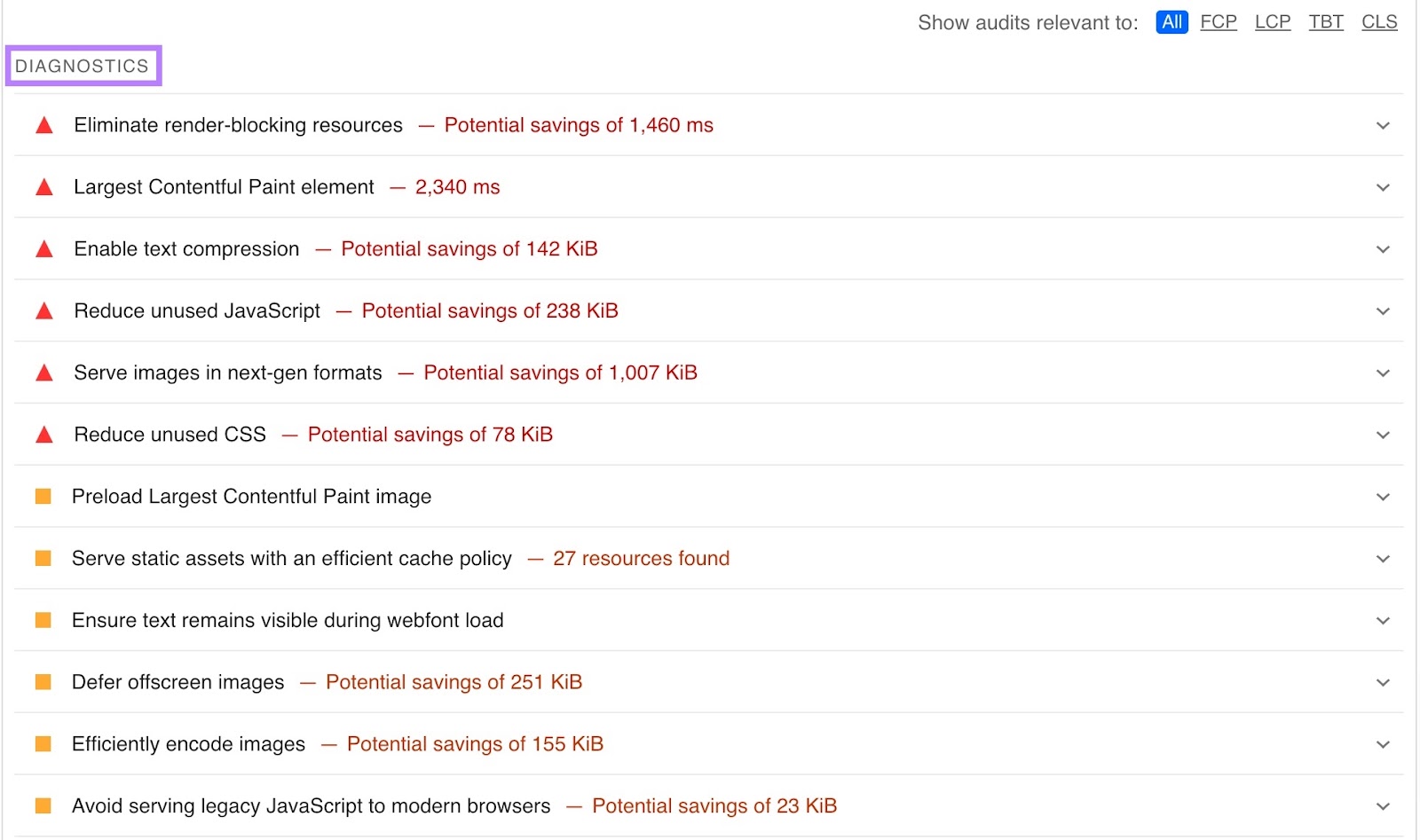
This part lists the efficiency audits that your web site didn’t cross, together with the potential financial savings if the problems are mounted.
You’ll be able to click on via every merchandise to dive deeper into what’s inflicting the problem. And how one can repair it.
After you implement the recommendations, rerun the evaluation to see if the web page’s efficiency has improved. And think about working the evaluation twice at totally different occasions of the day as a result of you possibly can typically get a distinct rating even with out making adjustments.
Easy methods to Examine Velocity Throughout Your Whole Website
To get a fuller image of how briskly your total web site is, use Google PageSpeed Insights together with Semrush’s Site Audit device. Which measures your web site’s pace and offers deep insights into the elements affecting it.
Open the device, enter your area, and click on “Begin Audit.”

Subsequent, observe the configuration instructions and click on “Begin Website Audit.”
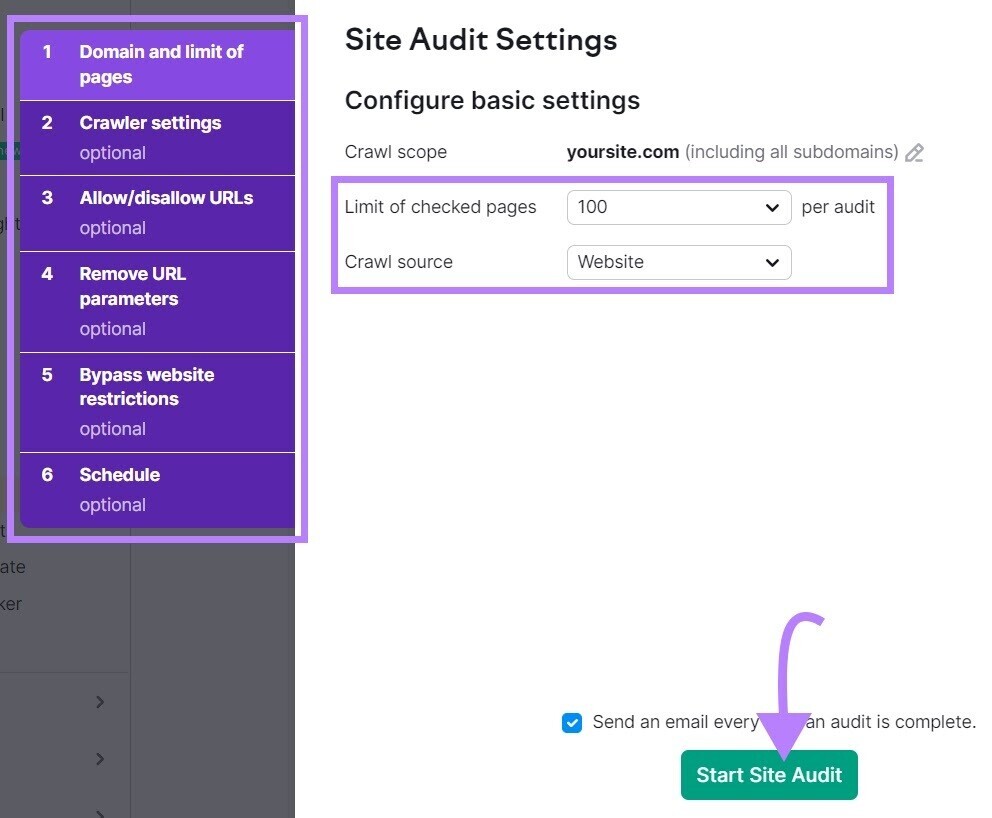
You’ll see a dashboard like this one.
Subsequent, click on “View particulars” below “Website Efficiency”.
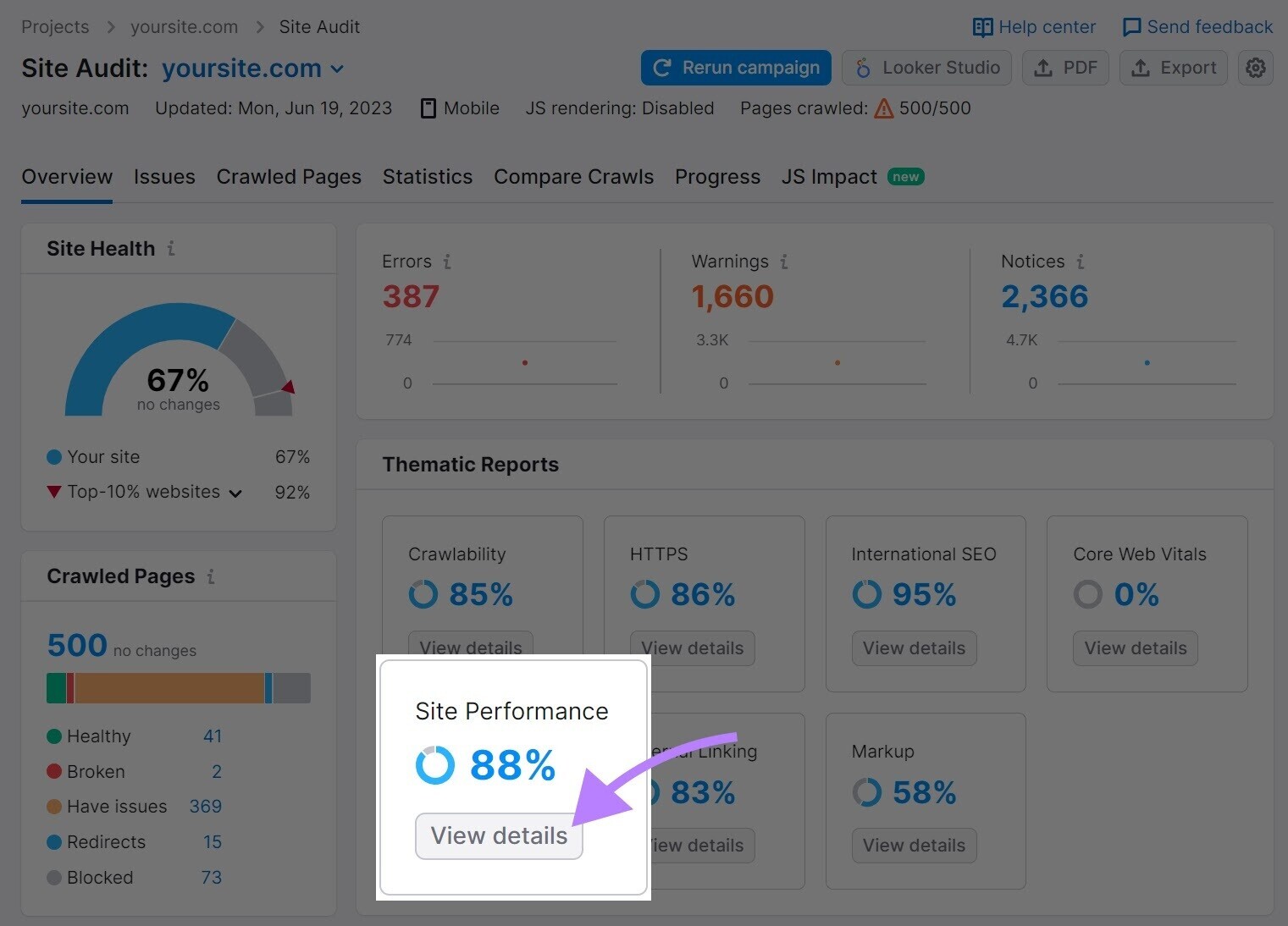
Throughout the “Website Efficiency” report, you’ll see your common web page load pace in seconds.
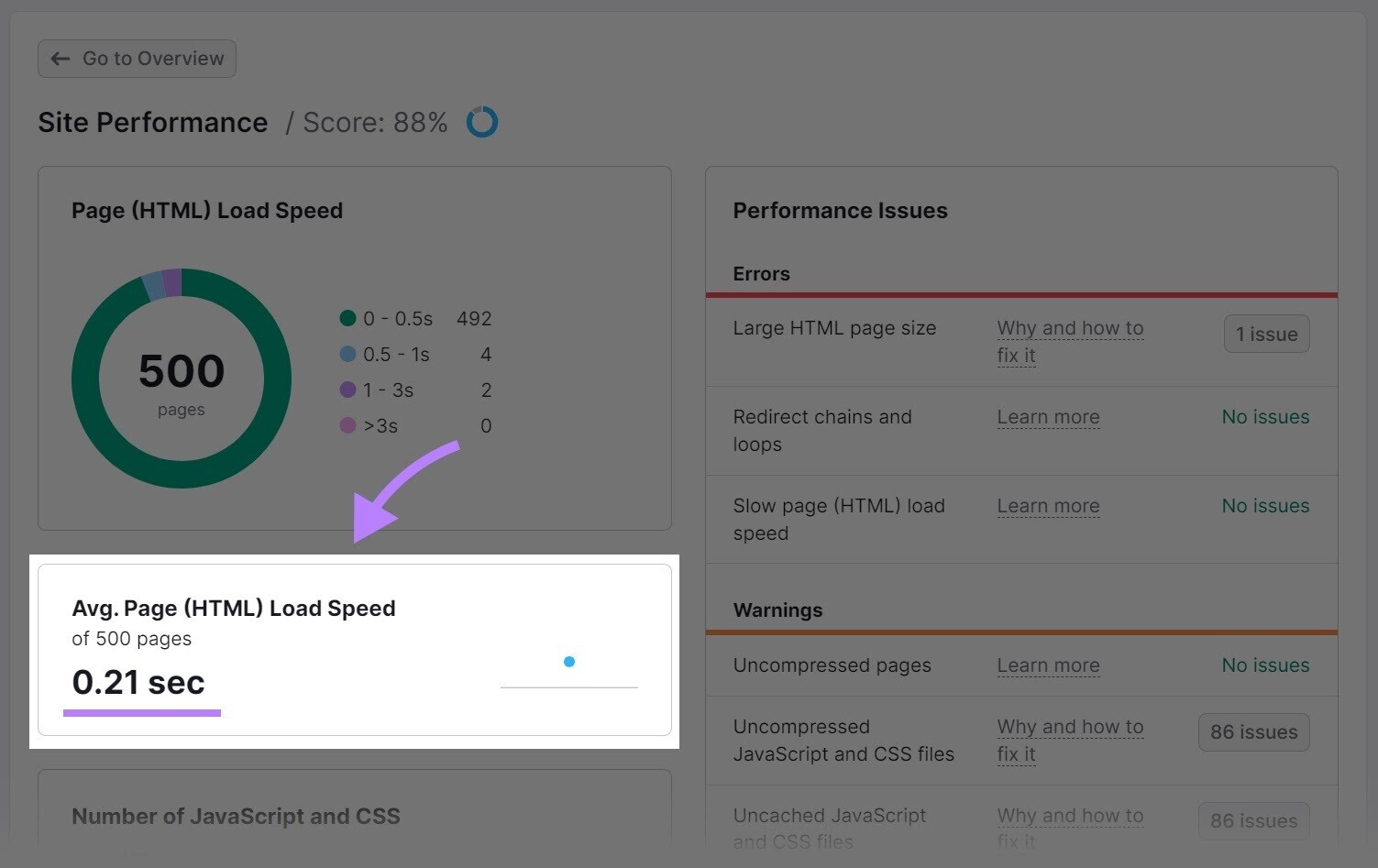
You’ll additionally see a listing of “Efficiency Points” you possibly can tackle to enhance pace throughout your web site.
Easy methods to Enhance Your Google PageSpeed Insights Rating
To enhance your PSI rating, you possibly can observe the suggestions out of your PageSpeed Insights report in addition to your Website Efficiency report in Site Audit.
Some recommendations could also be simple to implement your self (e.g., resizing pictures). Others might require the experience of an internet developer and/or a technical SEO specialist (e.g., decreasing unused JavaScript).
That mentioned, this is a step-by-step information to implementing a few of Google’s most typical PageSpeed Insights (PSI) recommendations to spice up your rating.
1. Eradicate Render-Blocking Sources
Render-blocking assets stop a webpage from loading shortly. It’s because assets corresponding to CSS, JavaScript, and font recordsdata drive the browser to load them earlier than displaying the web page.
Eliminating these roadblocks could make your web page load quicker and enhance your Google webpage pace take a look at rating.
To do this, observe these steps:
- Search for “Eradicate render-blocking assets” within the “Diagnostics” part of your PSI report.

- Click on on the arrow subsequent to the suggestion to see the checklist of assets which are inflicting the problem. Which can present you which of them assets are blocking the web page from rendering shortly—and the potential time financial savings in milliseconds.
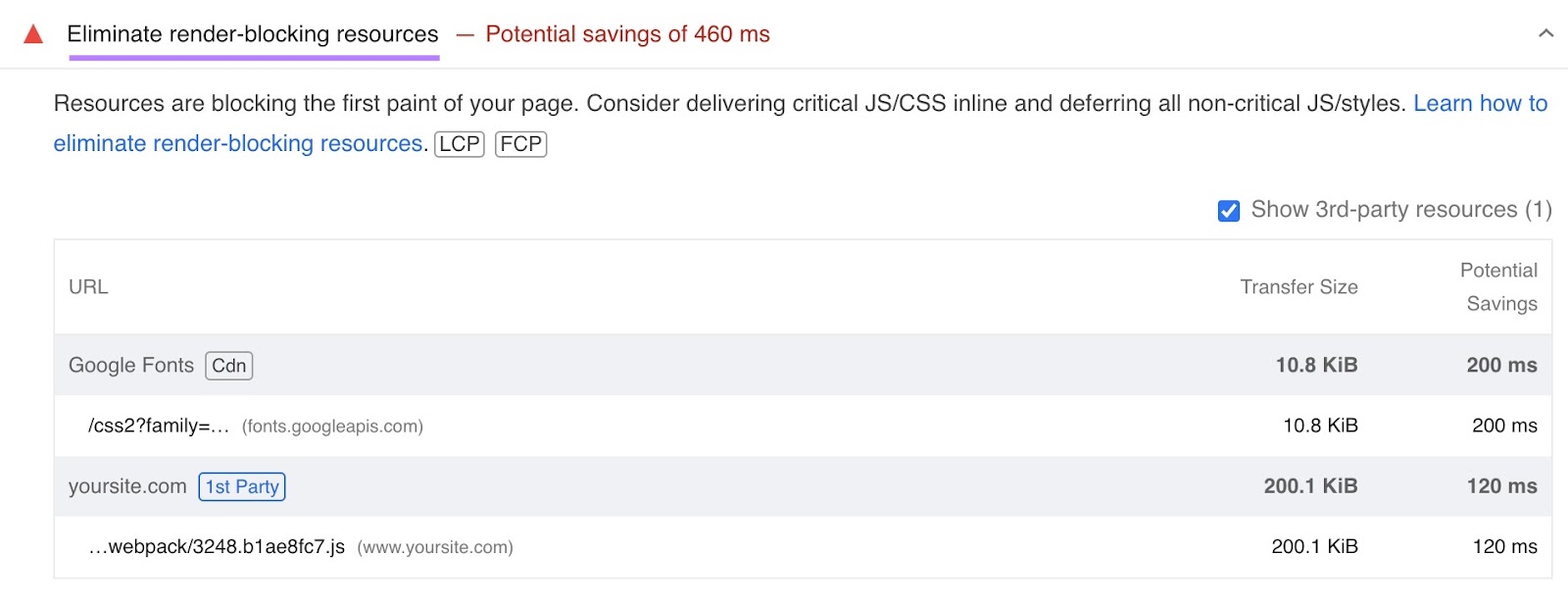
- When you’ve recognized the render-blocking assets, the subsequent step is to determine which of them aren’t important for the performance of the web site to allow them to be eliminated, inlined, or deferred.
When you’re not accustomed to coding or web site improvement, you’re prone to want developer help for this step.
2. Scale back Server Response Occasions
The server response time, also called time to first byte (TTFB), is the time it takes for the browser to obtain the primary byte of knowledge from the server. A gradual TTFB can negatively influence web page load pace, because it delays the time it takes for the browser to obtain the web page’s content material.
When a person tries to entry a webpage, the browser makes a community request to fetch that content material. The server then receives the request and returns the web page content material.
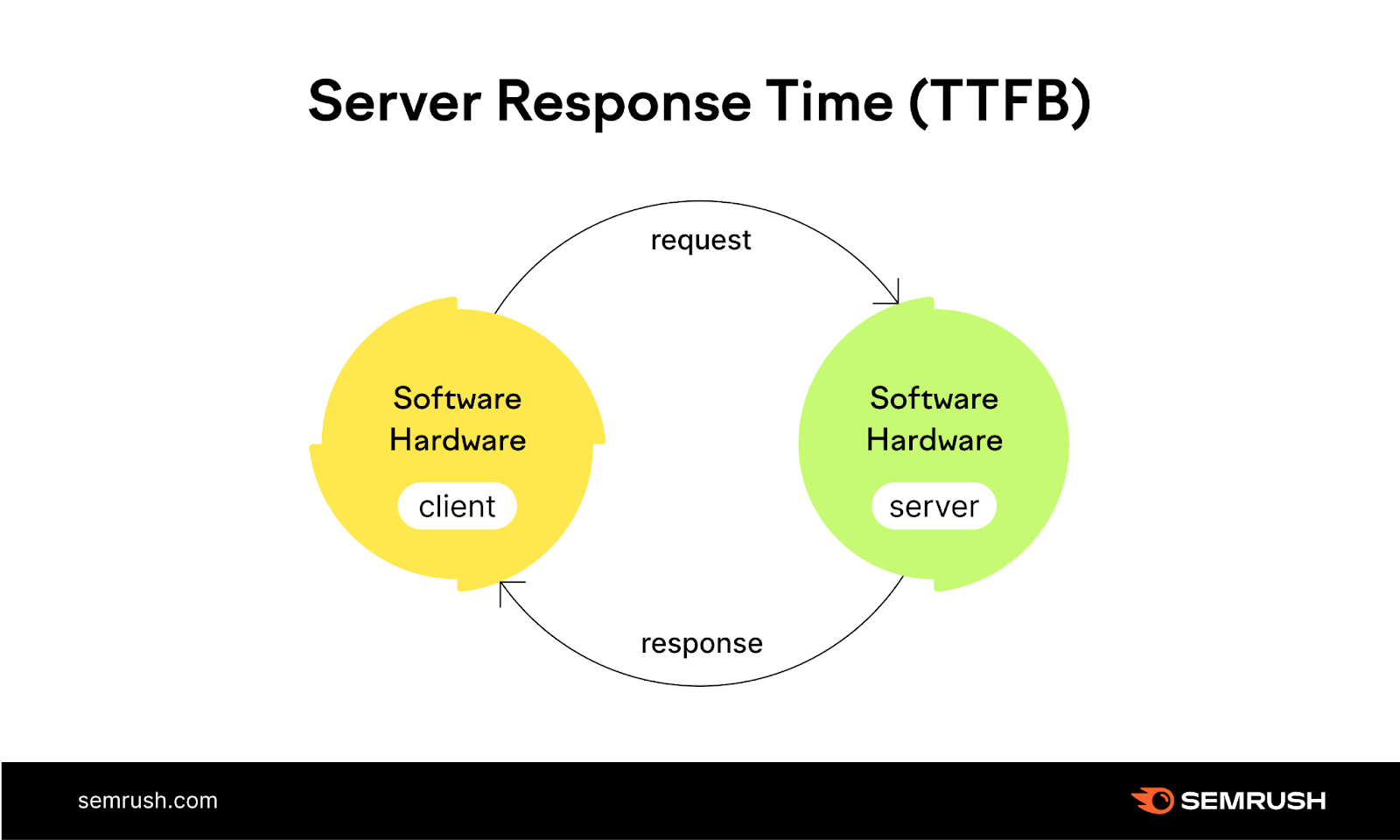
Google PSI will present the advice “Scale back preliminary server response time” when the browser waits more than 600 milliseconds for the server to answer the request.

To scale back server response occasions, you possibly can attempt the next:
- Select a web hosting service that provides quick servers and low latency
- Streamline the server’s software logic by optimizing code and eradicating pointless processes to generate pages quicker
- Correctly index database tables to enhance question efficiency. If wanted, think about upgrading to a quicker database system.
- Enhance server efficiency by including extra random-access reminiscence (RAM) and upgrading to quicker processors. So your server can deal with extra requests effectively.
- Use a content delivery network (CDN) to distribute your web page’s assets throughout a number of servers. This reduces the time it takes to ship these assets to the person.
You’re prone to want help from a developer or your internet host for this.
3. Optimize Your Photos
Images (particularly giant ones) can considerably enhance web page load pace.
The Google web site pace take a look at report exhibits you all pictures in your web page that aren’t appropriately sized and shows the present dimension and potential financial savings in kibibytes (KiB).
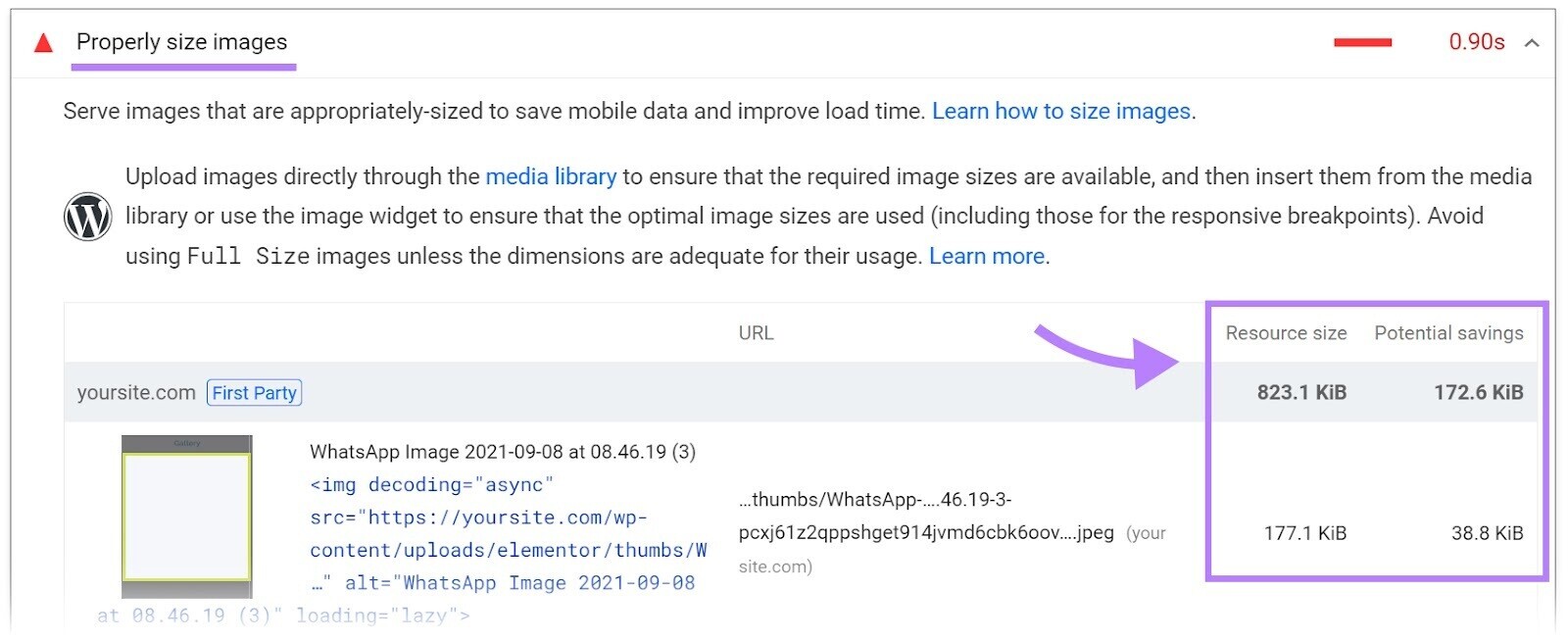
Resizing these pictures can prevent knowledge and enhance the web page load time.
There are a lot of methods to optimize your pictures. And the excellent news is that it’s comparatively easy.
You’ll be able to:
- Compress your pictures utilizing a device like TinyPNG or ShortPixel earlier than importing them to your web site
- Use the suitable picture format (JPEG, PNG, GIF, or WebP) for every picture to optimize the file dimension and preserve picture high quality
- Use the “srcset” attribute to serve the suitable picture dimension based mostly on the person’s system
- Lazy-load pictures utilizing a WordPress plugin like LazyLoad or Smush
When you have a WordPress web site, that is pretty easy to do your self. Right here’s how one can use TinyPNG to optimize your pictures:
- Log in to WordPress
- Click on “Add Plugin.” Then seek for “TinyPNG.” When you’ve discovered the plugin, click on “Set up” after which “Activate.”
- When you’ve registered your account, go to the “Media Library” and choose “Bulk Optimization.”
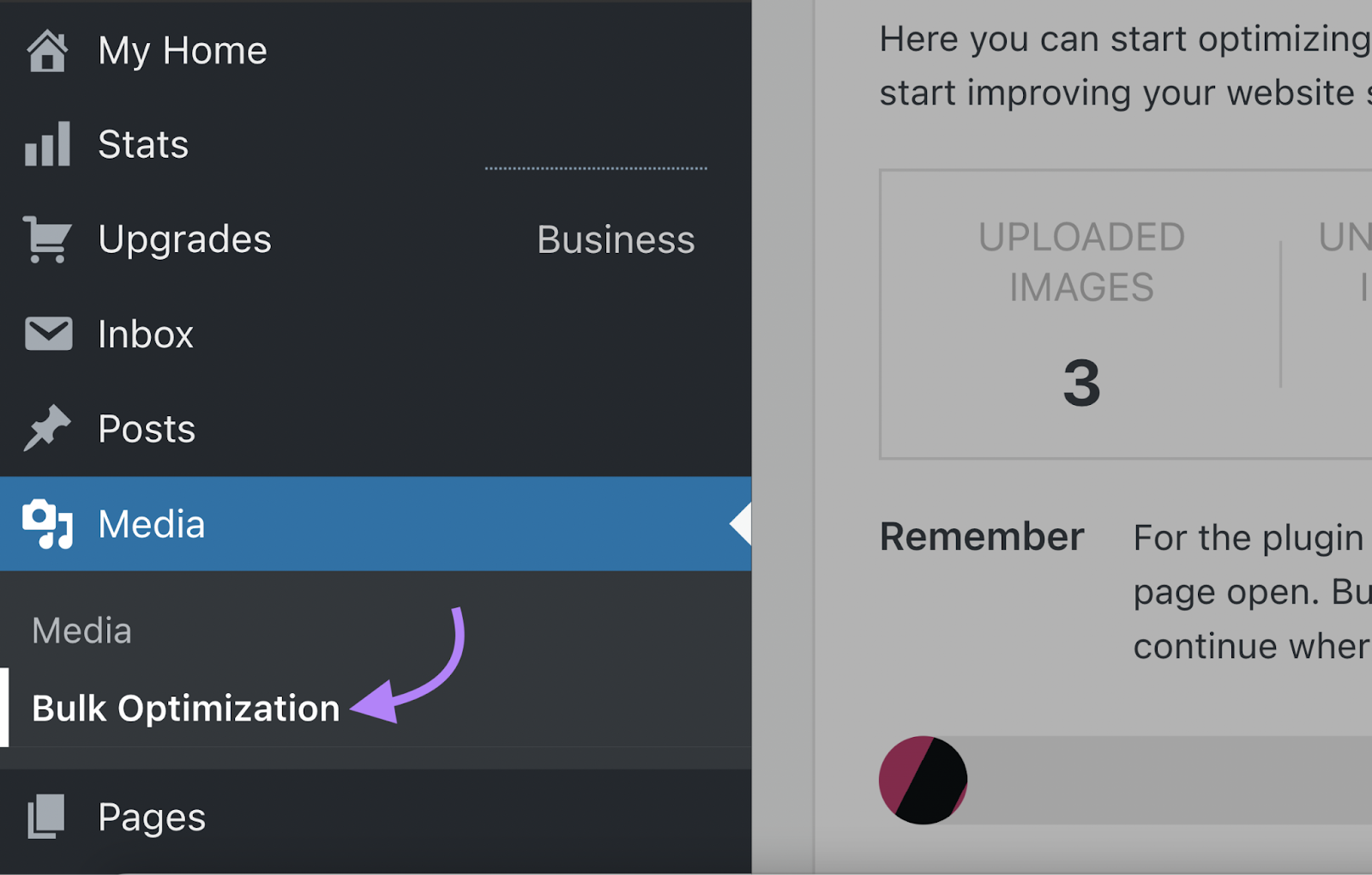
The plugin will present you what number of pictures you’ve uploaded and the way a lot house you’ve saved.
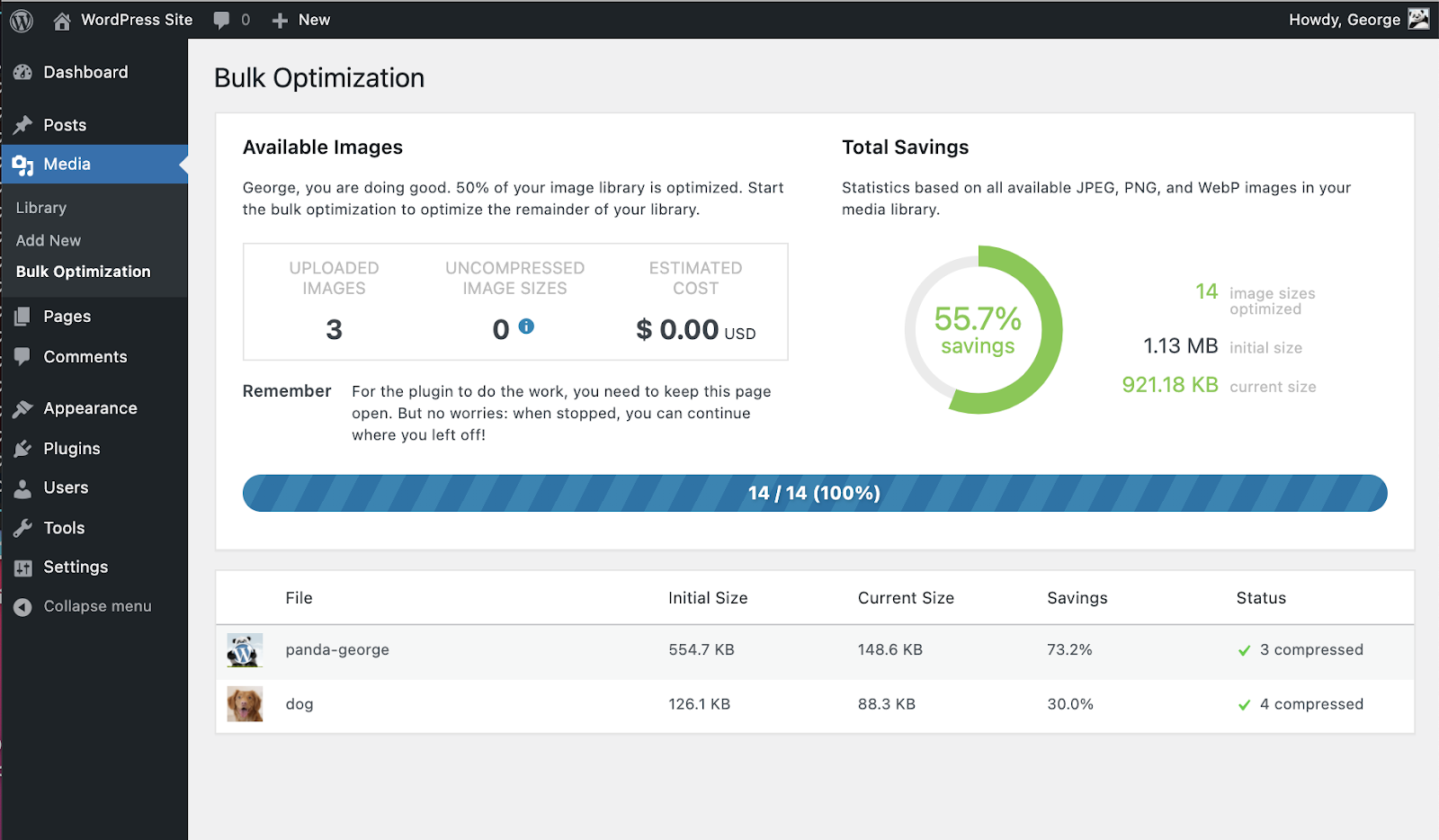
4. Keep away from Chaining Essential Requests
Chaining crucial requests is when a web page must obtain a number of recordsdata and belongings with a view to load.
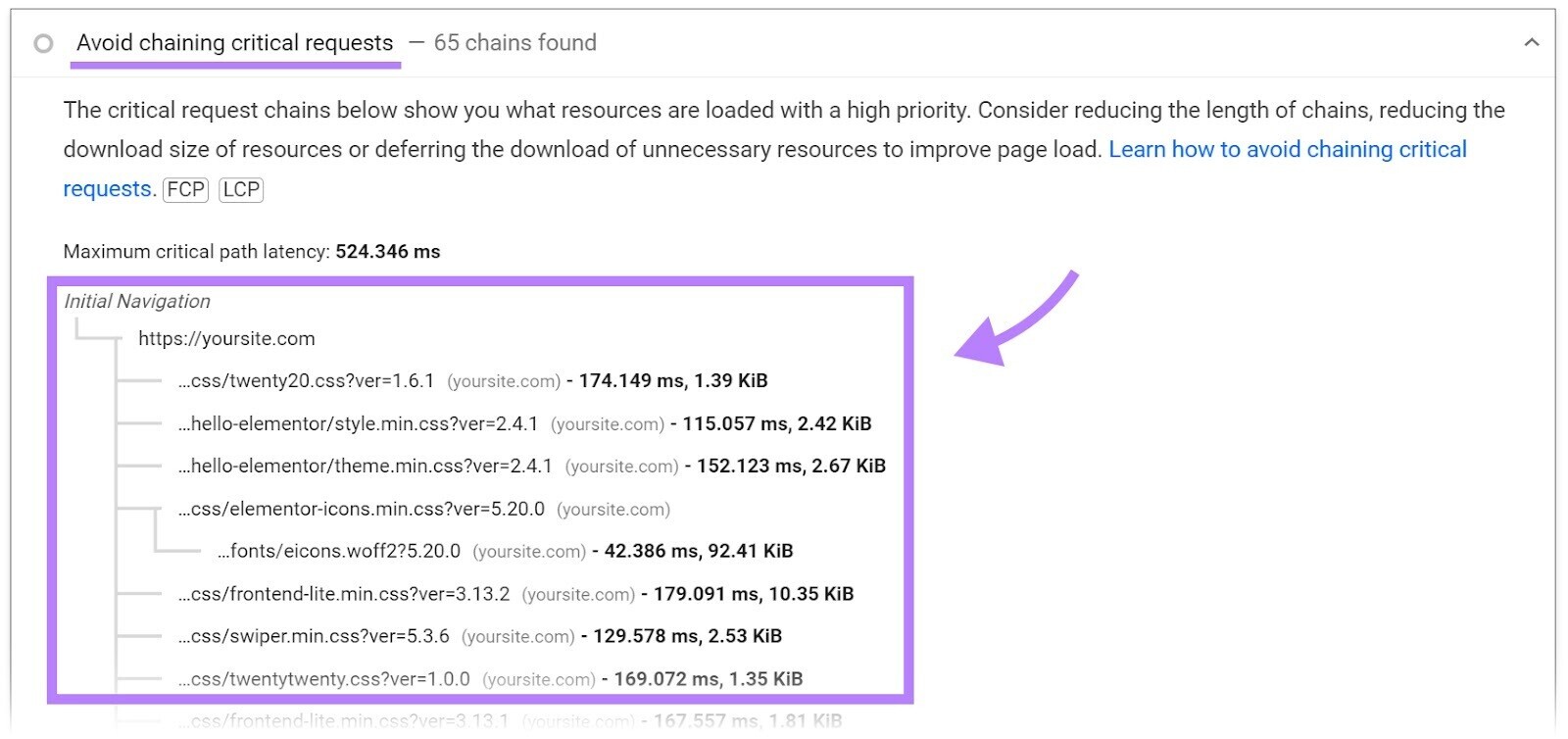
Let’s say you’re the ecommerce supervisor at a pet meals retailer.
In your touchdown web page for cat meals, the textual content gained’t present up till the pictures of cute kittens have loaded. And for the pictures to load, the CSS file must load first. And so forth.
Every request relies on the earlier request, creating a sequence. And if any of the assets doesn’t load, the browser gained’t render the web page. Which may trigger vital delays.
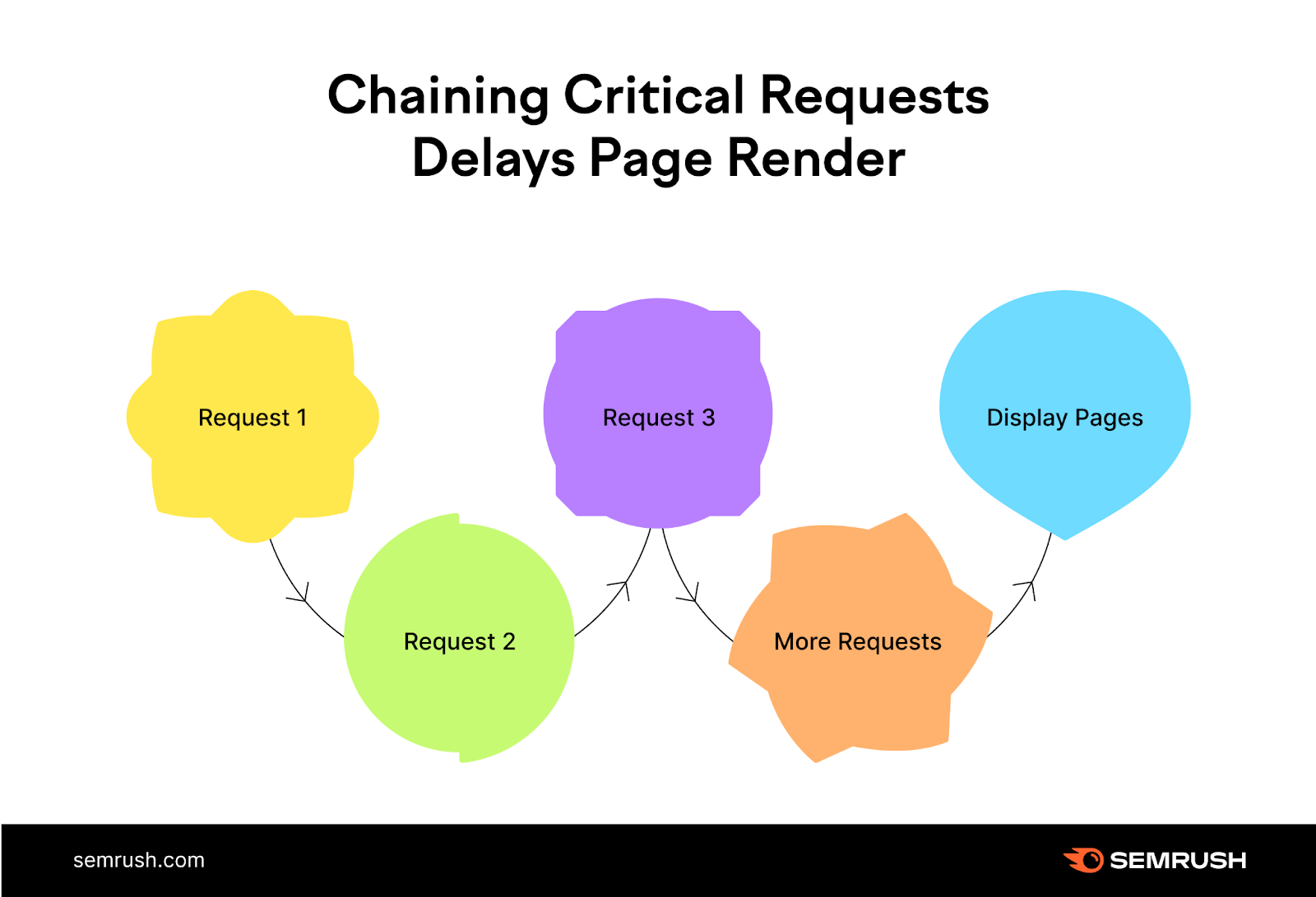
To keep away from these chains, you must set priorities. That approach, the crucial assets load first, so the web page will be displayed. And the much less vital issues are loaded afterward.
A great way to do this is by including the attributes “async” and “defer” to your web site code.
The “async” attribute tells the browser to proceed loading and exhibiting the remainder of the web page whereas the file or asset hundreds within the background.
The “defer” attribute instructs the browser to obtain the file or asset after the web page is seen to the person. This manner, the web page is displayed first, after which the non-essential stuff hundreds.
When you’re not capable of make adjustments to the web site code your self, you possibly can ask a developer so as to add the “async” and “defer” script tags for you.
It’s vital to notice that utilizing these attributes could cause points with sure sorts of scripts. So, ensure that to check completely earlier than implementing them in your web site.
5. Preload Key Requests
Preloading key requests means telling the browser to prioritize crucial belongings and obtain them first. That approach, essentially the most related recordsdata can load quicker.
Key requests are something the web page wants at an early loading stage. The most typical key requests are fonts. However this will apply to JavaScript recordsdata, CSS recordsdata, and pictures, too.

In case your web site runs on WordPress, you should use plugins like Preload Images and Pre* Party that help preloading.
In any other case, ask a developer to establish the crucial requests and add the preload tag to the code.
6. Scale back CSS and JavaScript
CSS is a crucial a part of internet design. However CSS recordsdata are sometimes bigger than they must be, which slows down your web site.
Equally, JavaScript is essential to the functioning of your web site. However it may additionally considerably decelerate your web site if the code isn’t optimized correctly.
Decreasing the dimensions of your code—a course of often called “minifying”—makes it load extra shortly.

Minifying your code includes eradicating pointless characters out of your CSS and JavaScript recordsdata. Equivalent to white house and feedback.
There are a lot of instruments to minify your code, corresponding to Toptal CSS Minifier, Toptal JavaScript Minifier, and Minify.
It’s also possible to think about using JavaScript frameworks or libraries which are designed to be light-weight and fast-loading. Like jQuery or React.
In case your web site is on WordPress, you should use a plugin to assist. Common plugins for CSS and JavaScript minification embrace Hummingbird, LiteSpeed Cache, and W3 Total Cache.
Right here’s how one can use Hummingbird to minify your code:
- Log in to WordPress and choose “Plugins” from the dashboard menu
- To put in Hummingbird, click on “Add Plugin” then “Activate”
- Discover “Hummingbird” within the dashboard menu, and full the setup wizard
- Then head again to the “Dashboard”
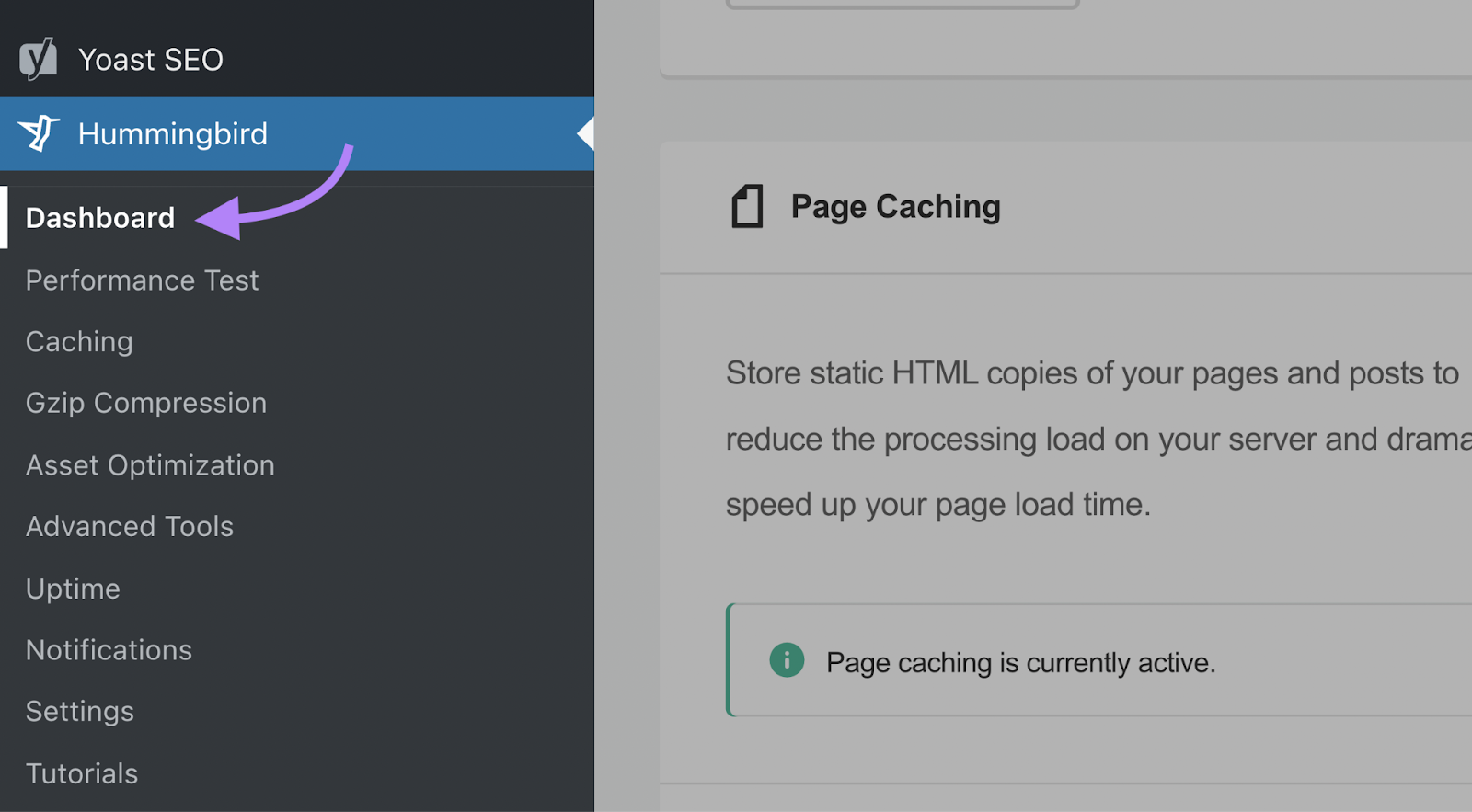
- Examine that your recordsdata are marked “Lively” within the Gzip Compression part.
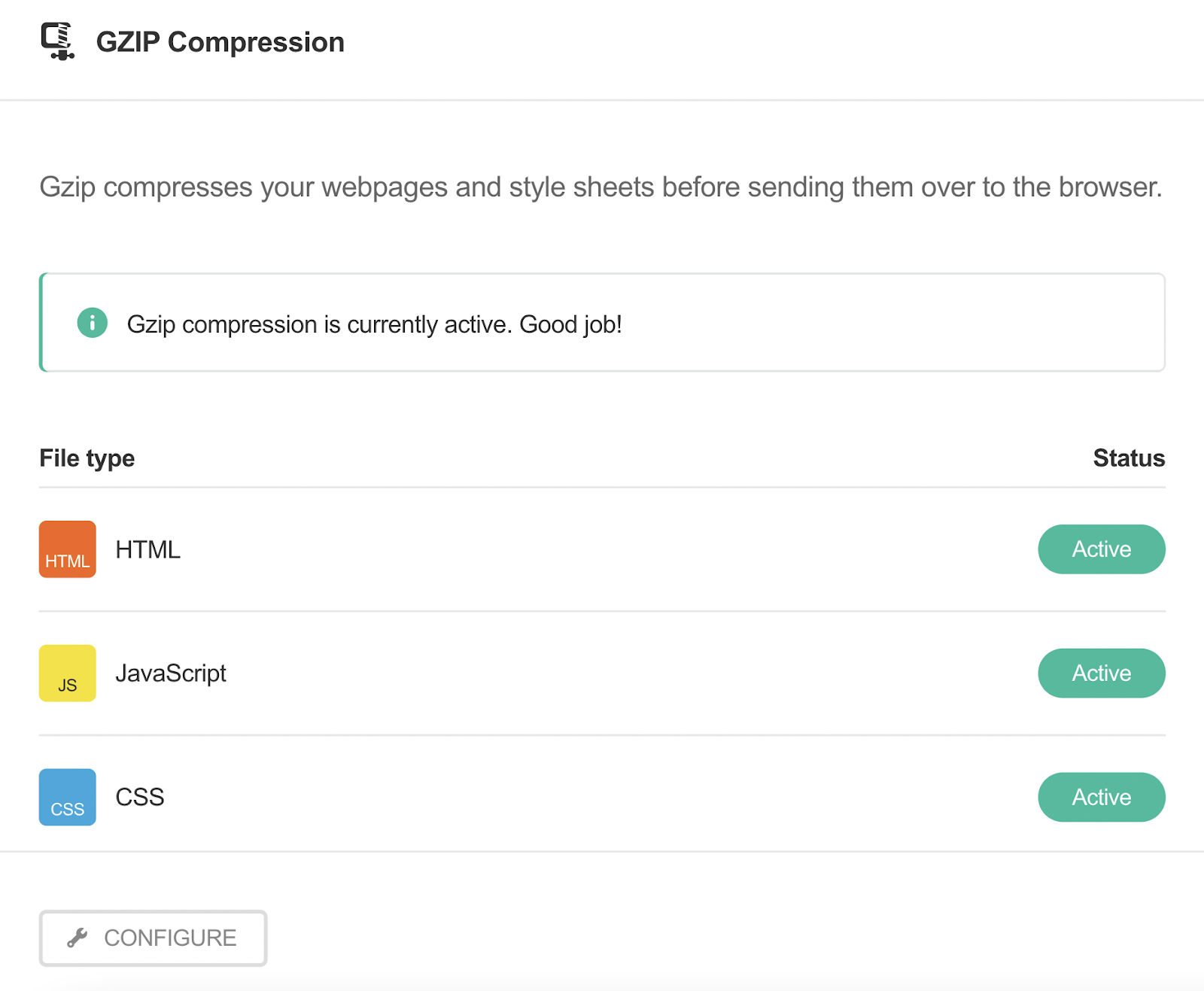
Try our guide to JavaScript SEO for extra detailed directions on how one can optimize the JavaScript code in your web site.
7. Defer Offscreen Photos
One other strategy to tackle gradual web page speeds related to pictures is to defer loading for offscreen pictures—that means pictures that aren’t seen on the display however are nonetheless being loaded by the browser.
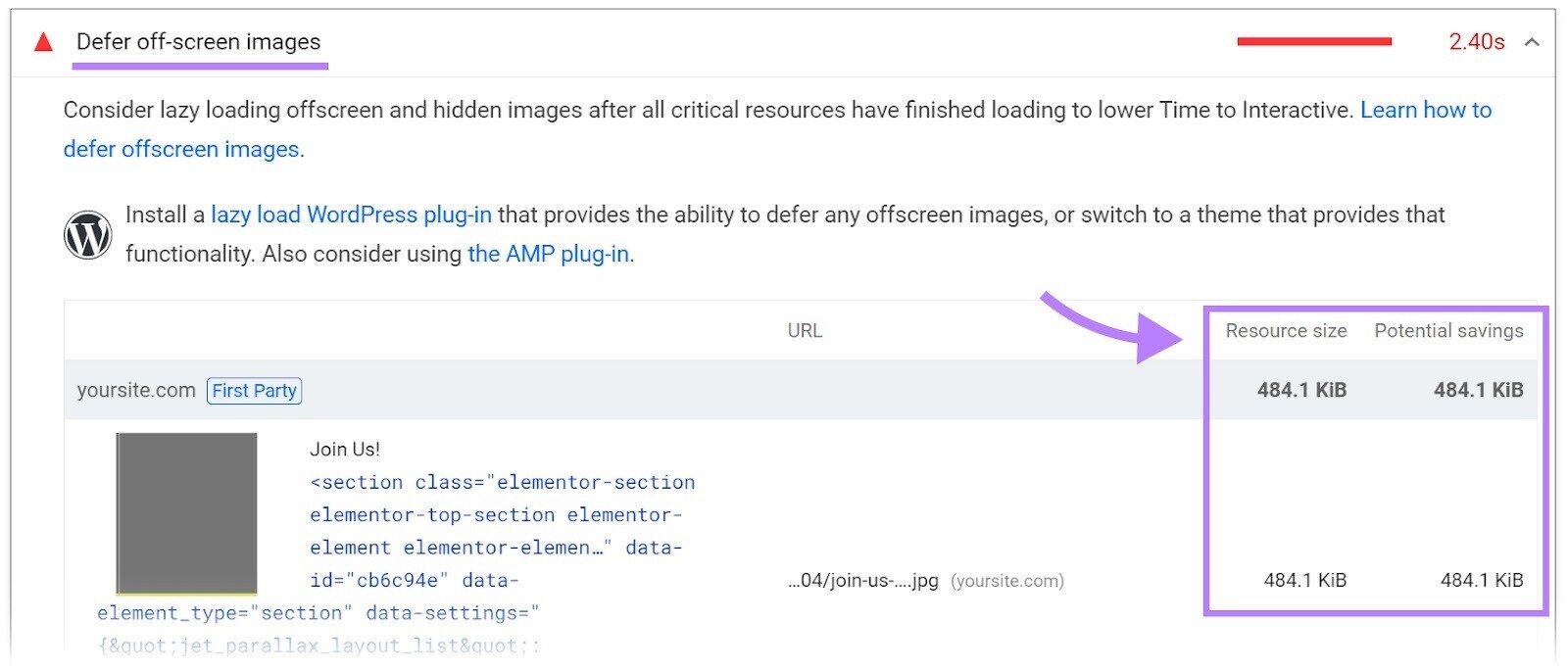
By deferring loading for non-visible pictures, you possibly can prioritize the pictures that are seen. So, the web page can load quicker.
You are able to do this utilizing lazy loading. Which suggests loading pictures solely once they’re wanted. Equivalent to once they become visible on the display.
This may considerably scale back the period of time it takes to load a web page, particularly on cellular gadgets with slower web connections.
WordPress has plugins that may do this for you, corresponding to Lazy Loader.
8. Scale back Doc Object Mannequin Measurement
The Doc Object Mannequin (DOM) is a tree-like illustration of the HTML construction of a webpage. A big DOM dimension can result in gradual loading occasions and a poor person expertise.

To scale back your DOM dimension, you possibly can:
- Ask your dev crew to take away pointless components and attributes from the HTML code and take away unused JavaScript or CSS recordsdata
- Use server-side rendering (SSR) to render pages on the server earlier than sending them to the shopper
- Keep away from (most) visible web page builders as a result of they generate inflated HTML
- Don’t paste textual content into what-you-see-is-what-you-get (WYSIWYG) web page builders
- Search for clean-coded themes and plugins
Instruments like Google’s Chrome DevTools will help you analyze your DOM dimension and establish areas for enchancment. It’s possible you’ll want developer help to implement the adjustments.
9. Repair A number of Web page Redirects
Redirects robotically ahead site visitors from one URL to a different. They’ll additionally decelerate your web page load pace.
Let’s say you attempt to entry a web page that’s been redirected. The server tells your browser that the web page has moved. Then, your browser tries to retrieve the brand new URL. This extra step makes it longer to load the brand new web page.
One redirect already impacts web page pace. However typically, you possibly can run into points with a number of consecutive redirects. These are often called redirect chains.
Redirect chains typically occur as outdated pages get deleted and newer ones take their place. Because of this, there may be a couple of web page between the unique URL and the ultimate URL. Like this:
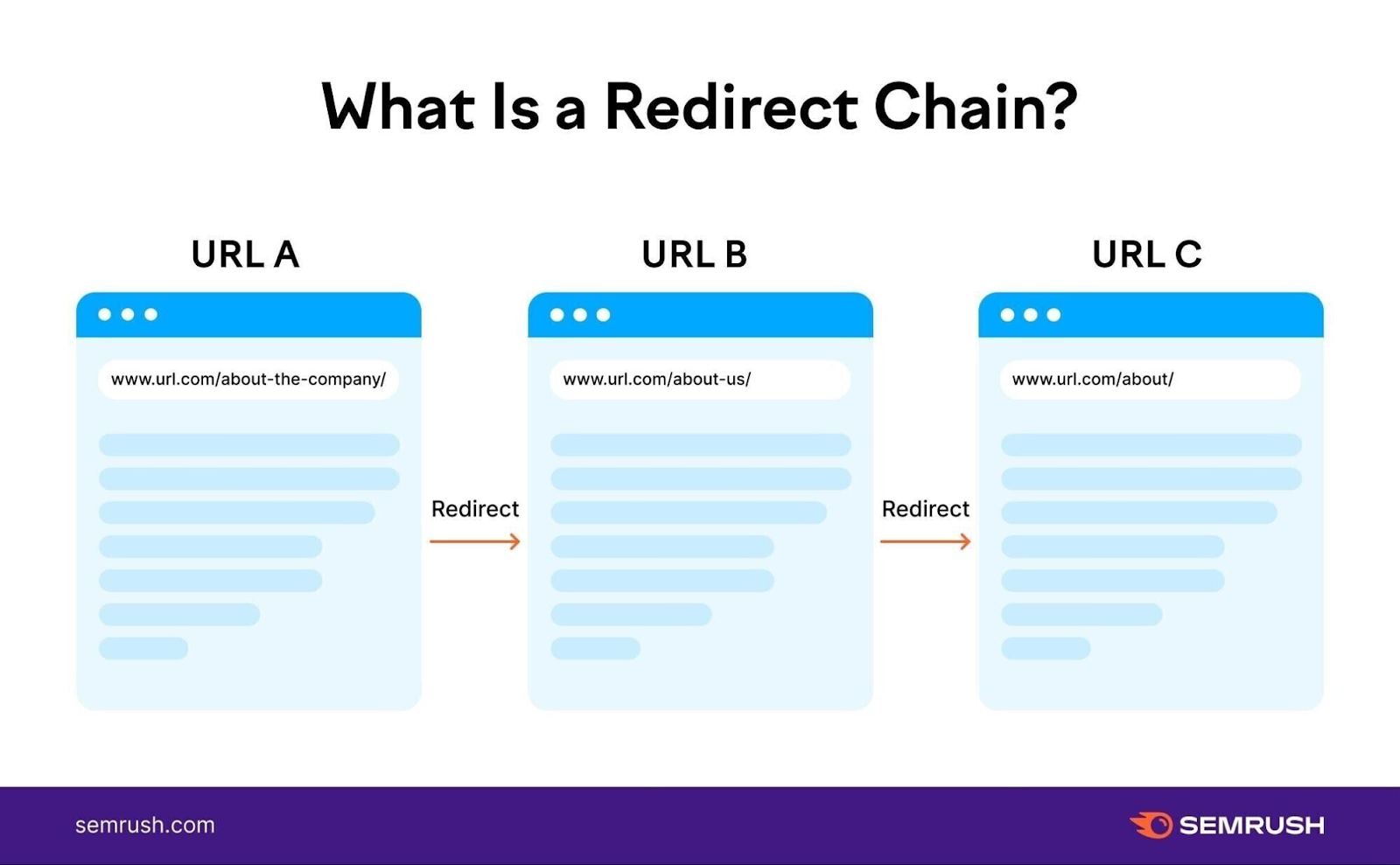
Google can follow up to 10 redirects with out reporting a difficulty in Google Search Console. However redirect chains can unnecessarily decelerate your web site.
So, it’s finest to maintain issues easy to enhance your PageSpeed Insights rating. And it’s best to redirect straight from the unique URL to the most recent URL.
The simplest strategy to get an summary of the redirects in your web site is with an website positioning device like Site Audit.
Click on the “Points” tab and sort “redirect” into the search bar.
Then, click on on “# redirect chains and loops.”
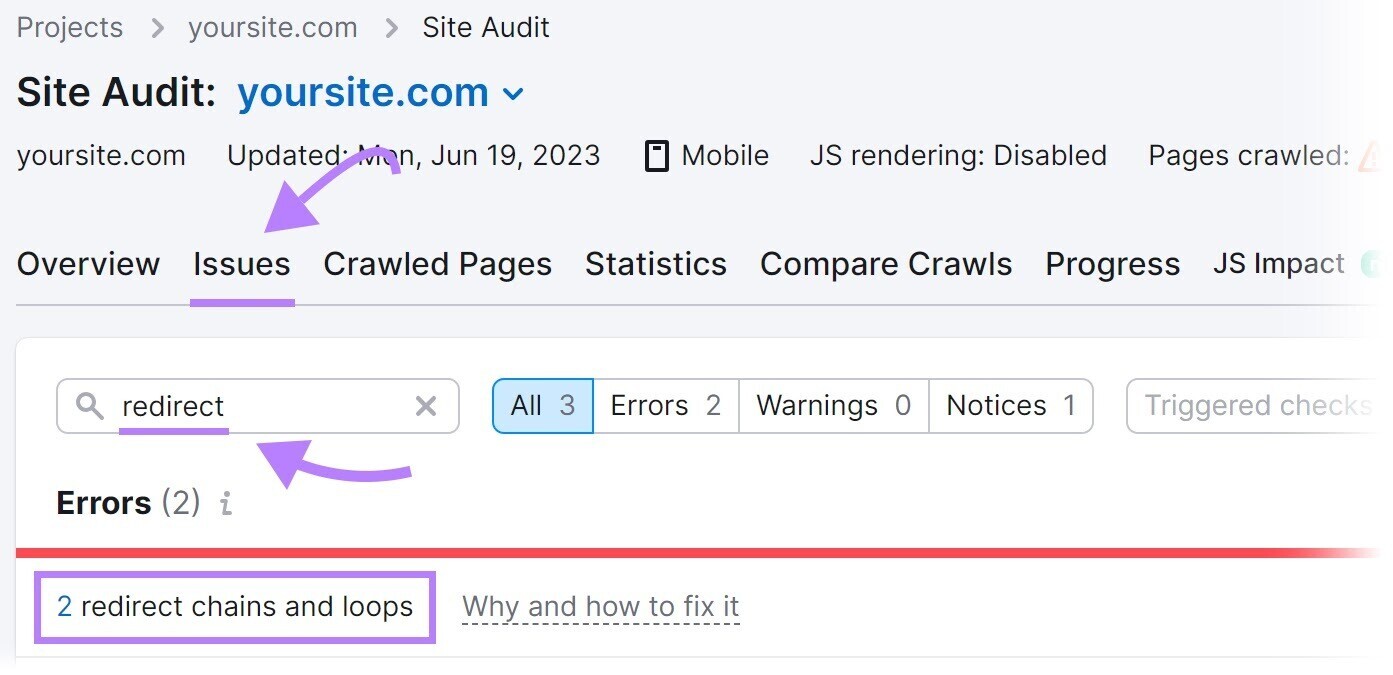
It will present you a report containing a listing of pages, their redirect sort, and the variety of redirects.
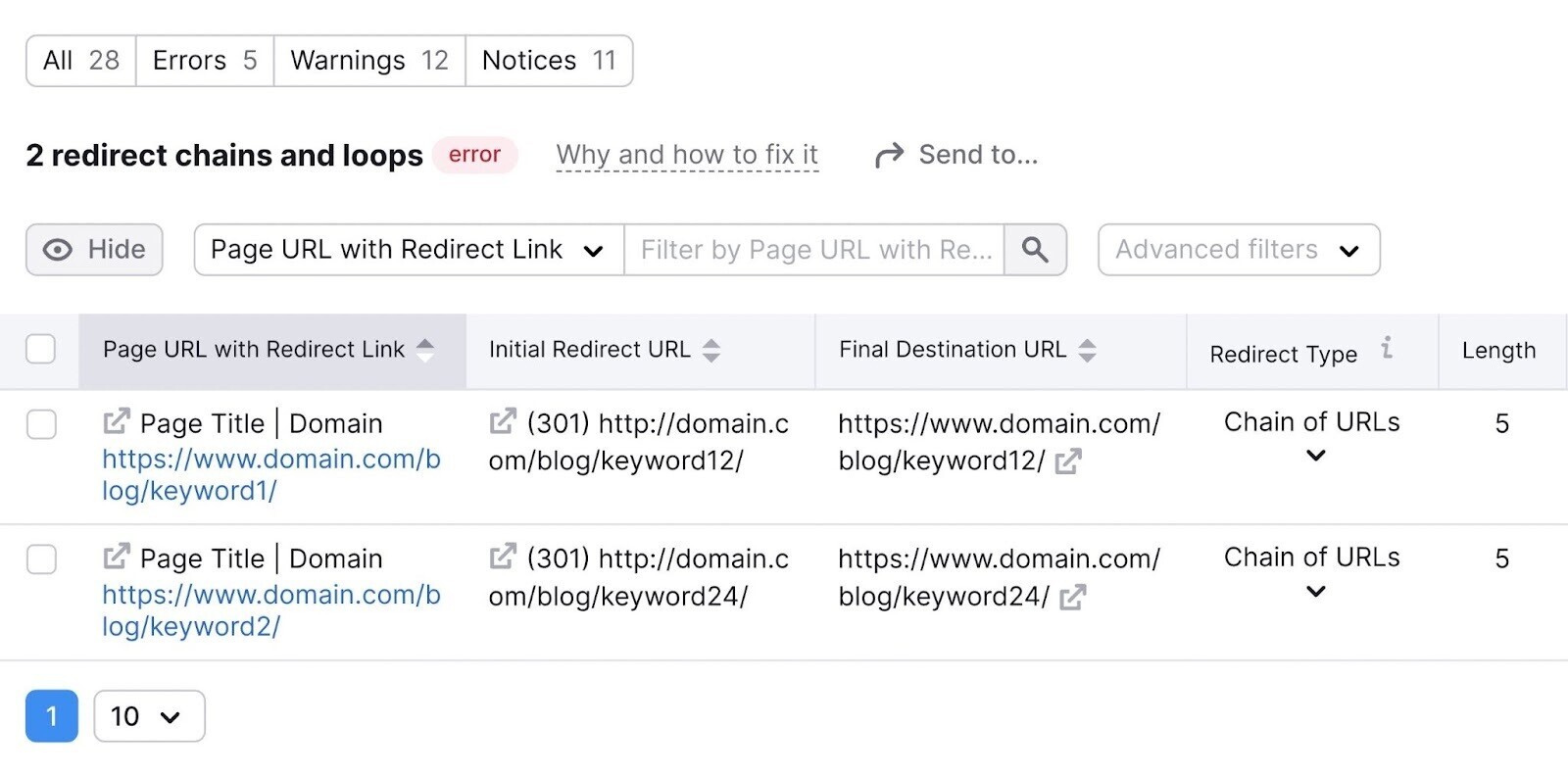
When you’ve recognized any redirect chains, you possibly can possible log in to your content material administration system (CMS) to repair them. You’ll have to delete the pointless redirects and implement a brand new redirect sending site visitors solely from the unique web page to the present one.
Many free WordPress plugins (together with Easy Redirect Manager, Redirection, and Simple Page Redirect) will enable you modify or arrange redirects.
Right here’s how one can do it with Simple Redirect Supervisor:
1. Log into WordPress, click on “Plugins” after which “Add New.”
2. Seek for “Simple Redirect Supervisor.” Then, click on “Set up and activate.”
3. Then click on “Handle Redirects.”
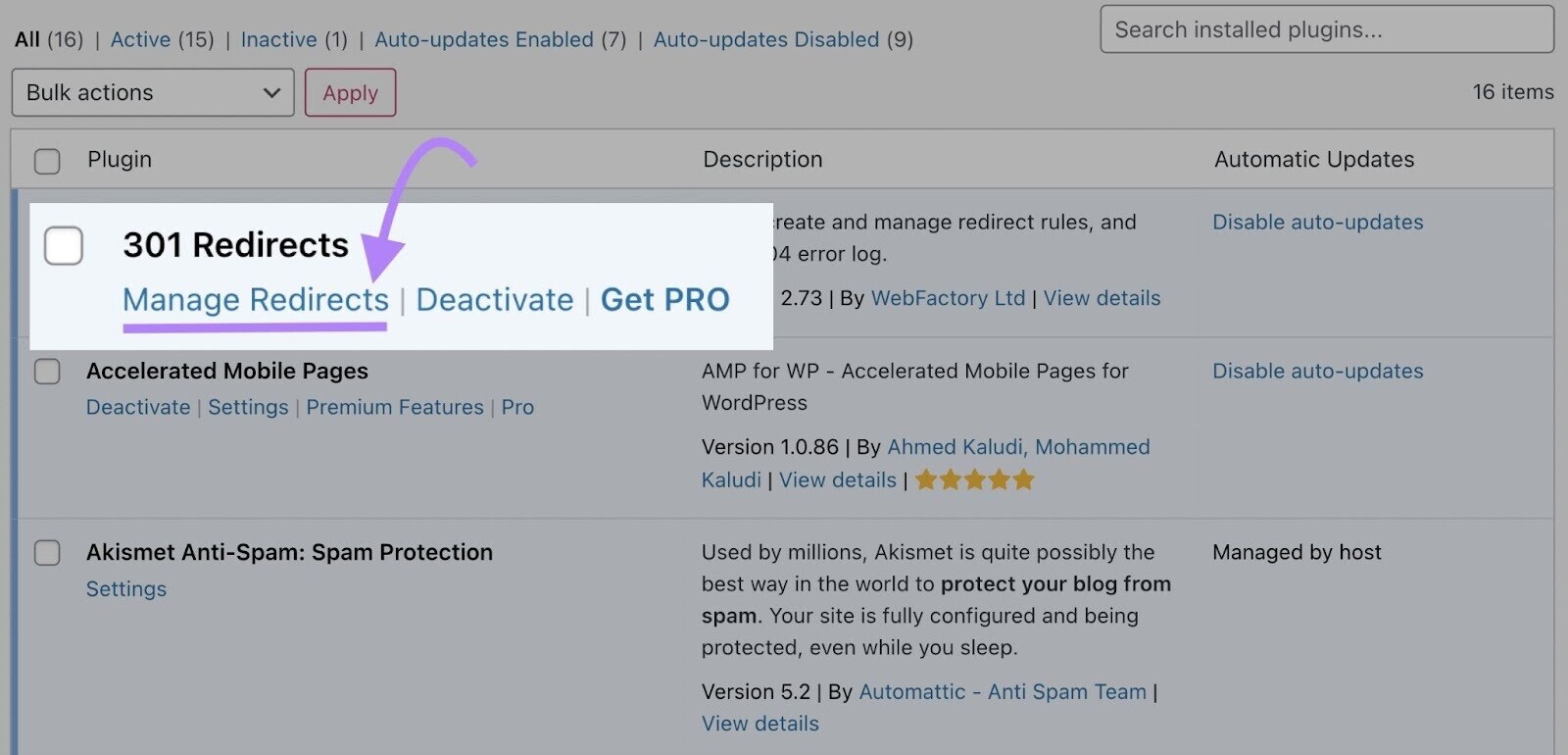
4. Within the “Redirect Guidelines” tab, enter the tackle of the outdated URL and the one you need to redirect to. And click on “Save.”
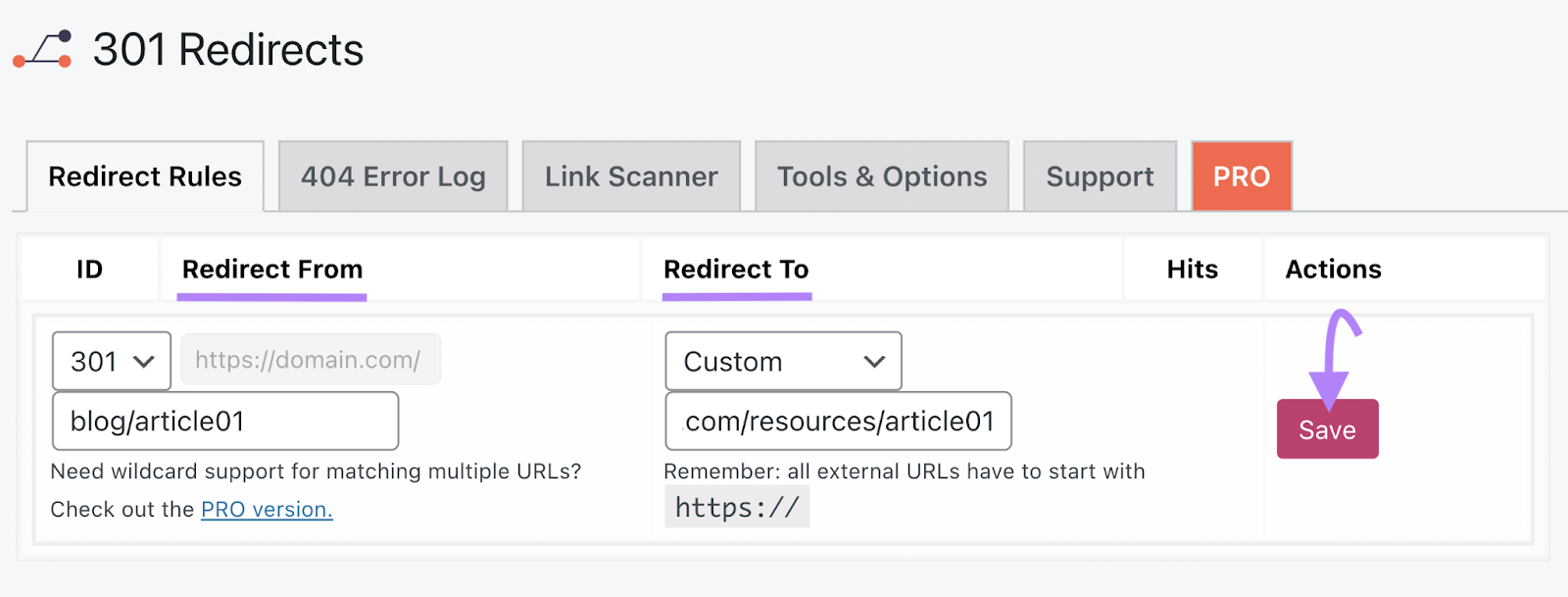
10. Keep away from Overusing Third-Social gathering Code
Third-party code contains scripts, pixels, and plugins. It could possibly decelerate web page loading occasions and negatively influence your PageSpeed Insights rating.
Third-party code usually comes from different corporations—corresponding to analytics instruments and advertisers—monitoring your web site efficiency.
Some third-party code is critical and helpful. As an illustration, you may need the Google Analytics pixel to measure web site efficiency. Or the Fb pixel to trace advert campaigns.
However you possible have some pointless third-party code. Like instruments and platforms you not use.
That’s why it’s best to recurrently audit third-party code in your web site. And take away something that isn’t needed.
In your PageSpeed Insights report, Google flags third-party code. Together with the switch dimension and main-thread blocking time.
Pay particular consideration to the corporate names within the grey bars. These are the third-party corporations working code in your web site. Google additionally categorizes them (Tag Supervisor, Social, Utility, Analytics) that will help you perceive their goal.
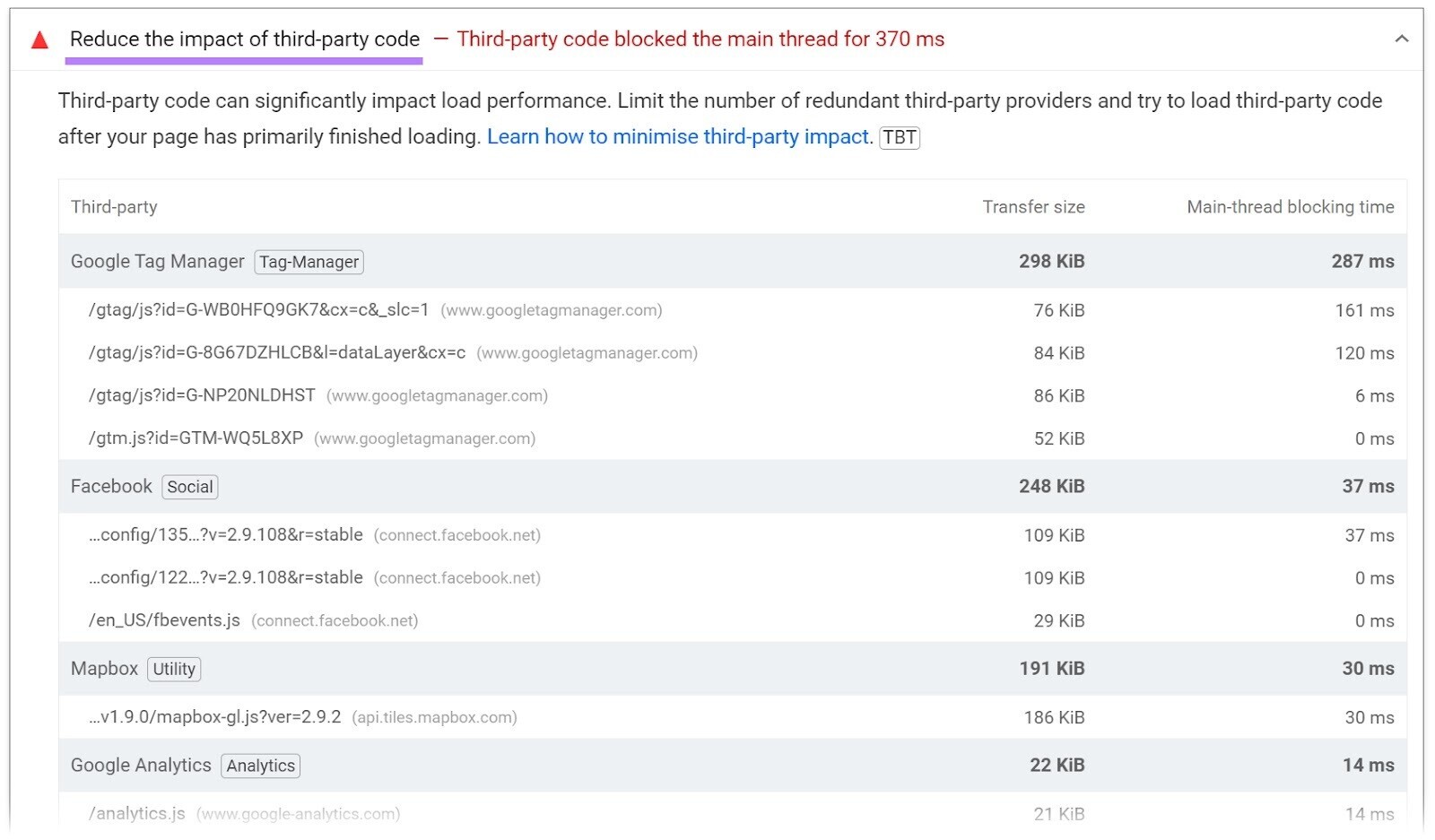
Make word of any firm names you don’t acknowledge or not want. And take steps to take away their code.
That is prone to contain deleting the code out of your CMS, uninstalling plugins in case your web site is on WordPress, or eradicating tags out of your tag administration device.
Audit Your Website to Monitor & Repair Web page Points Sooner
If you wish to conduct a extra detailed web site audit, use the Site Audit Tool. It scans your web site for over 140 technical and website positioning points. And generates an in-depth report that identifies all areas needing enchancment.
Let’s have a look:
Head to the device and choose your web site.
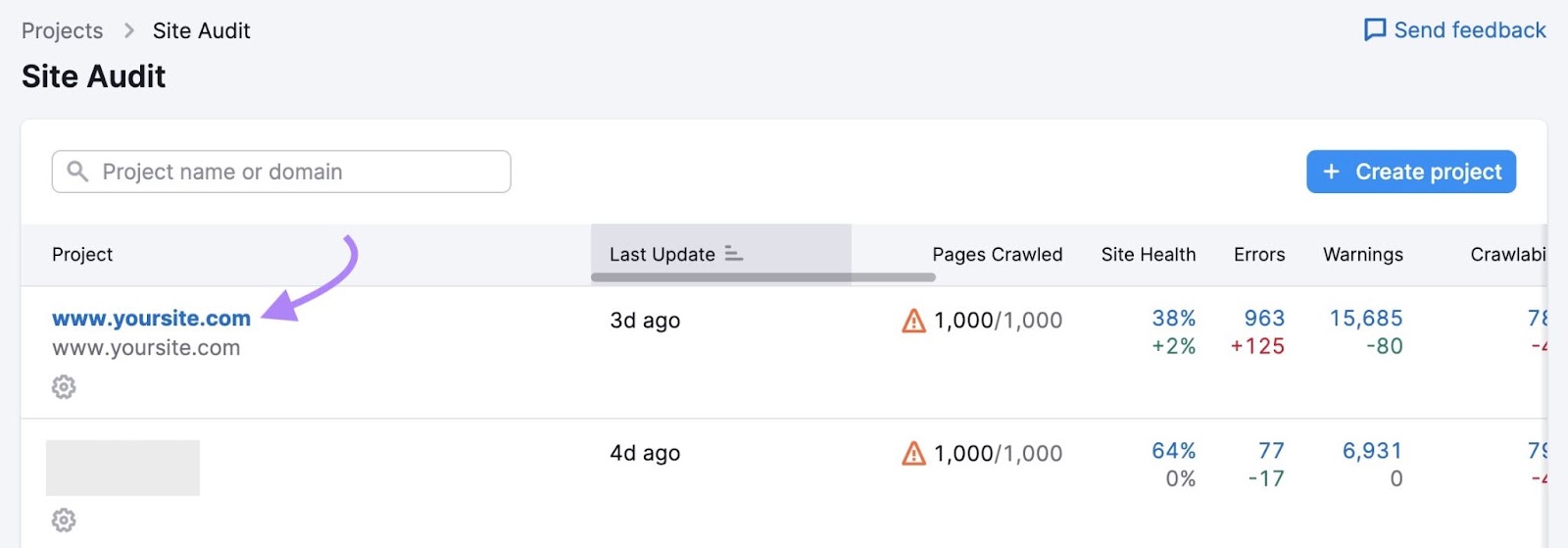
Within the “Overview” tab, you’ll see the “Website Well being” metric.
This metric exhibits your web site well being rating on a scale from 0 to 100. And tells you the way it stacks up towards different websites in your trade.
You’ll additionally see an summary of the “Errors,” “High Points,” and so forth. discovered in your web site.
Subsequent, click on on the “Points” tab.
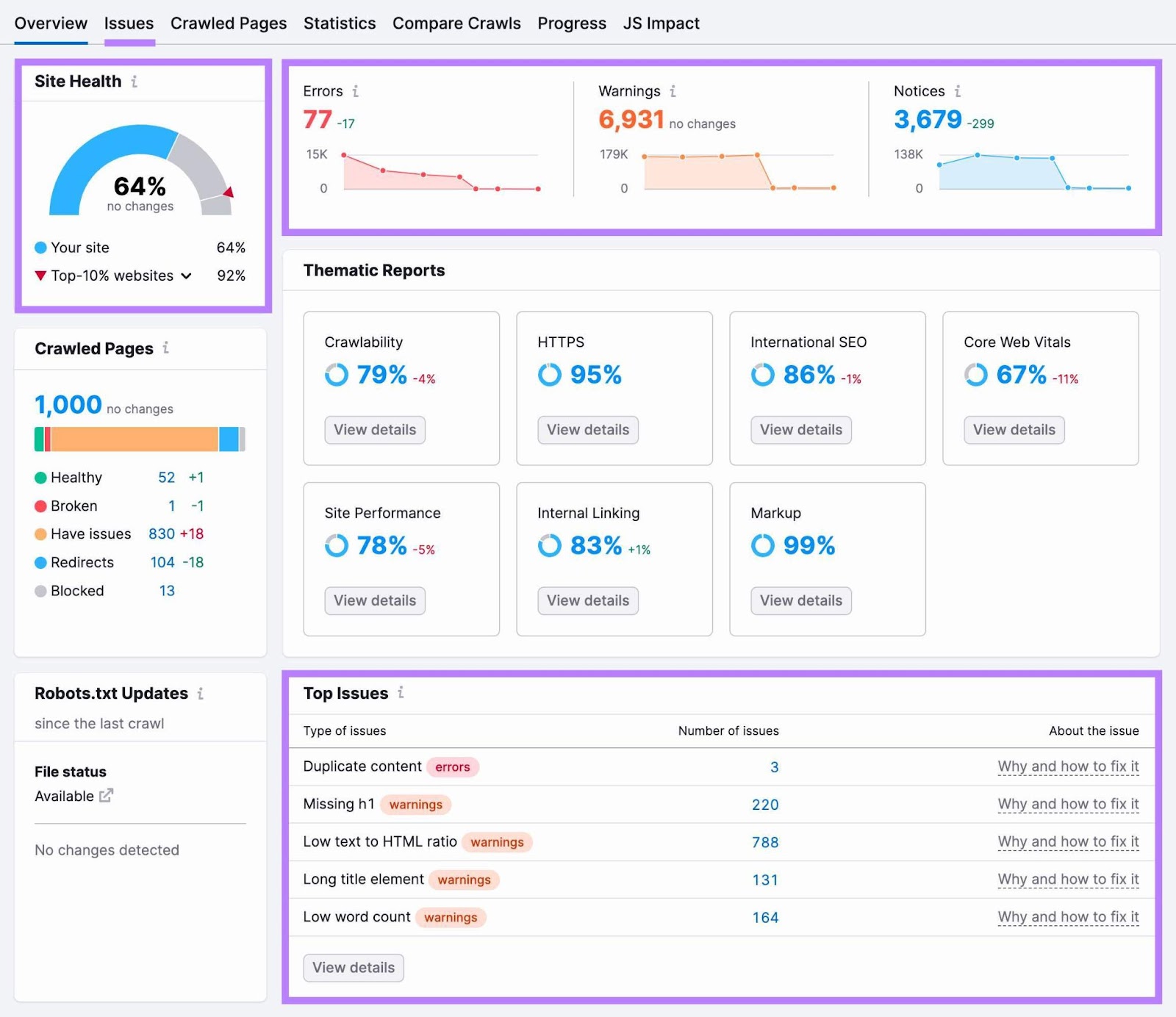
The device will present you an entire checklist of “Errors,” “Warnings,” and “Notices” that want your consideration.
It’ll additionally spotlight the variety of affected pages.
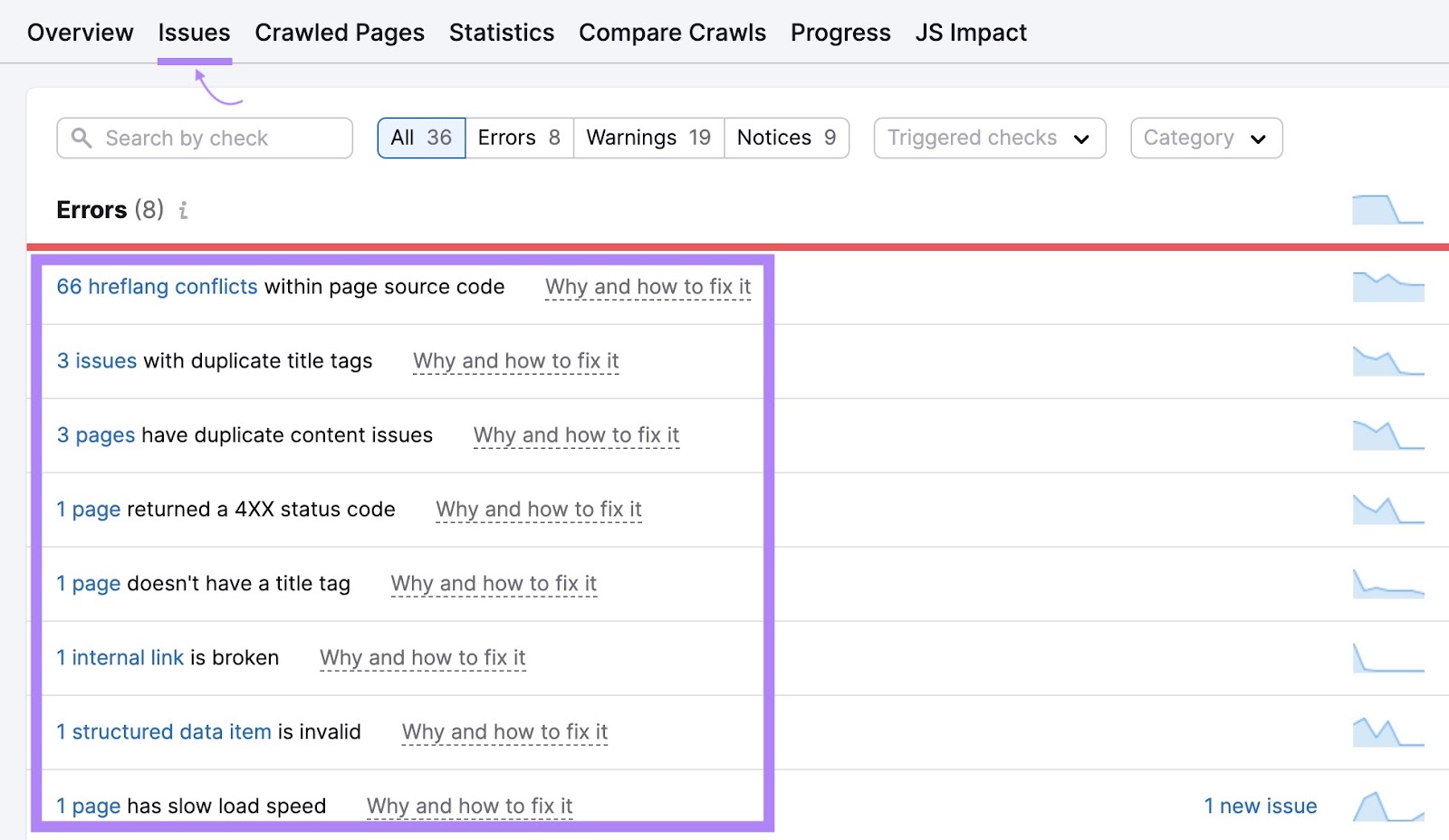
Click on on “Why and how one can repair it” to see the small print of a particular challenge. And the answer to repair the problem.
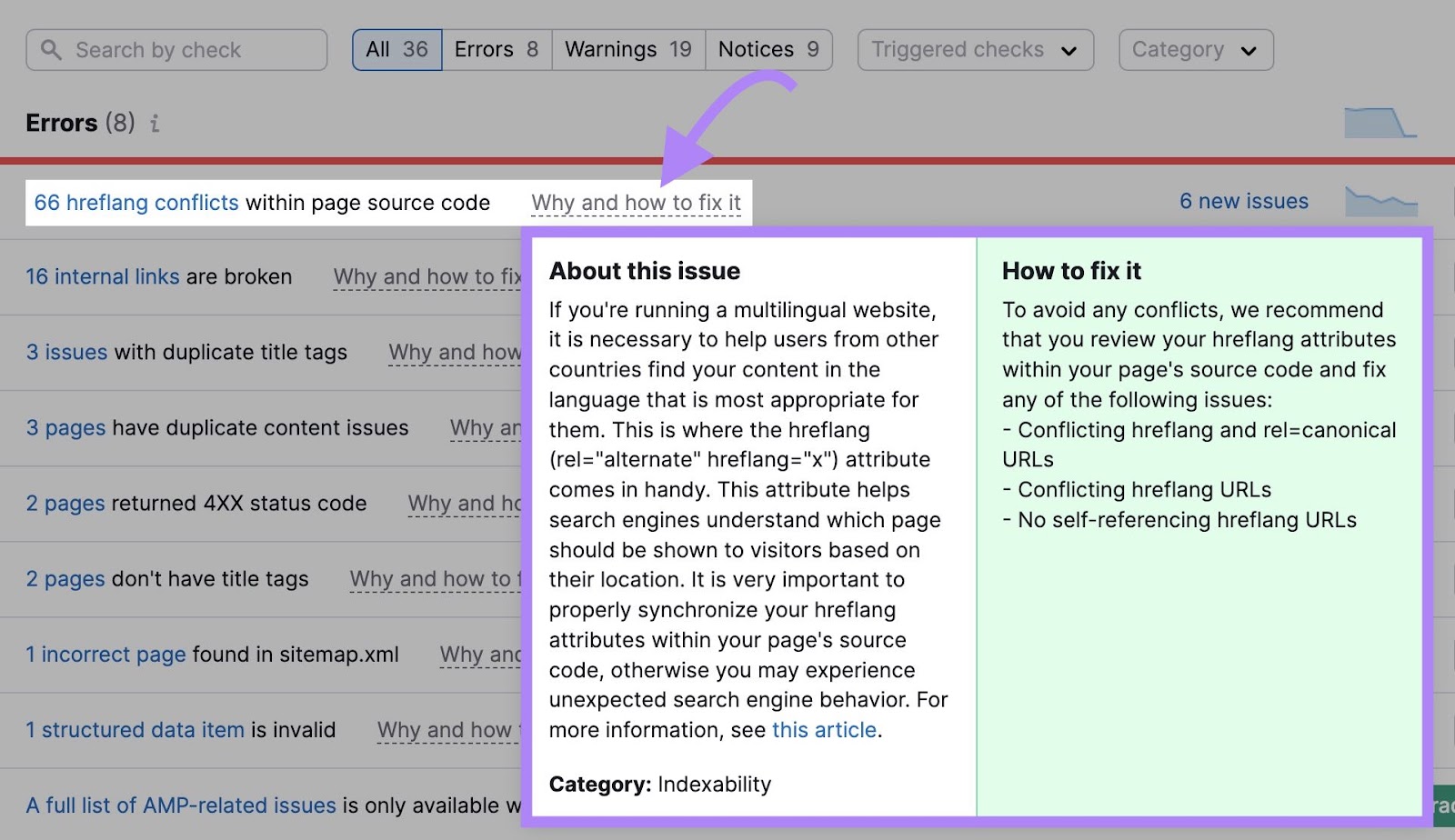
It will enable you establish and resolve most points that have an effect on your web site’s total well being and website positioning, along with enhancing the PSI rating.
Plus, Semrush exhibits your progress over time. Like this:
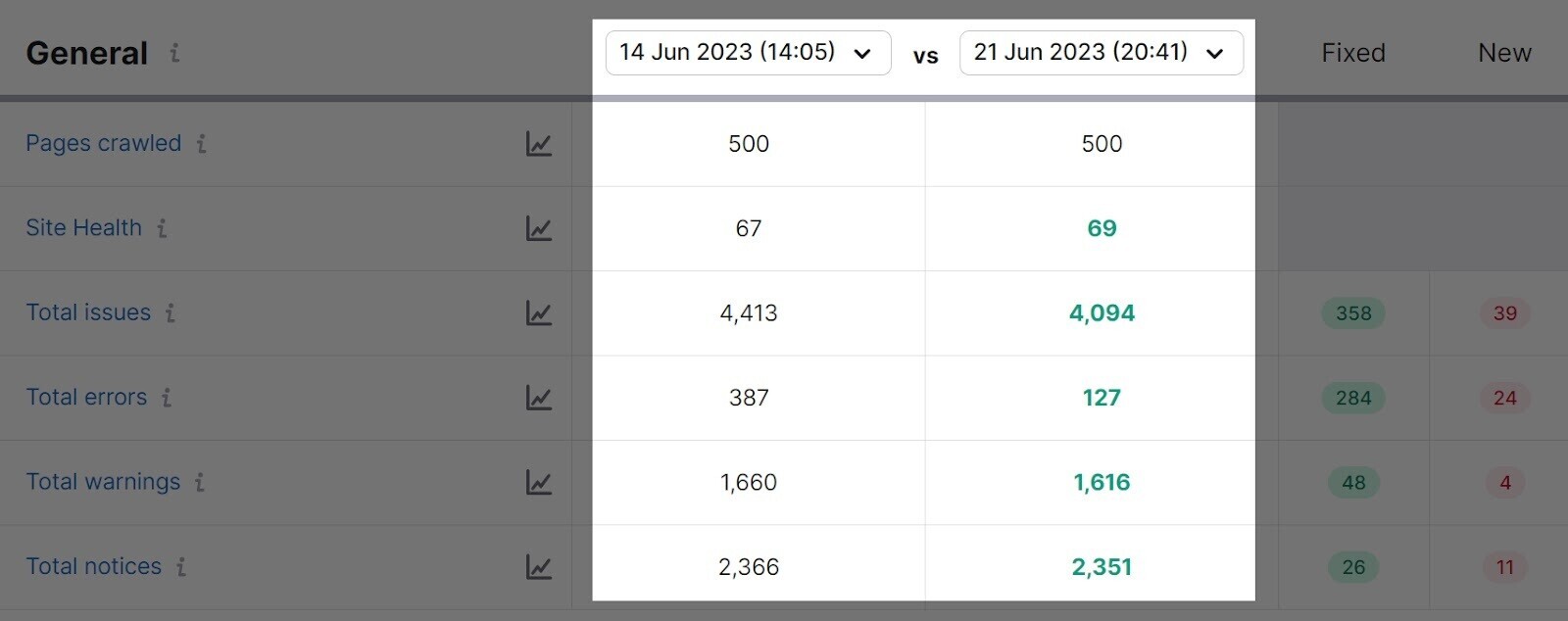
You’ll be able to even arrange automated audits to remain on prime of any points that come up.
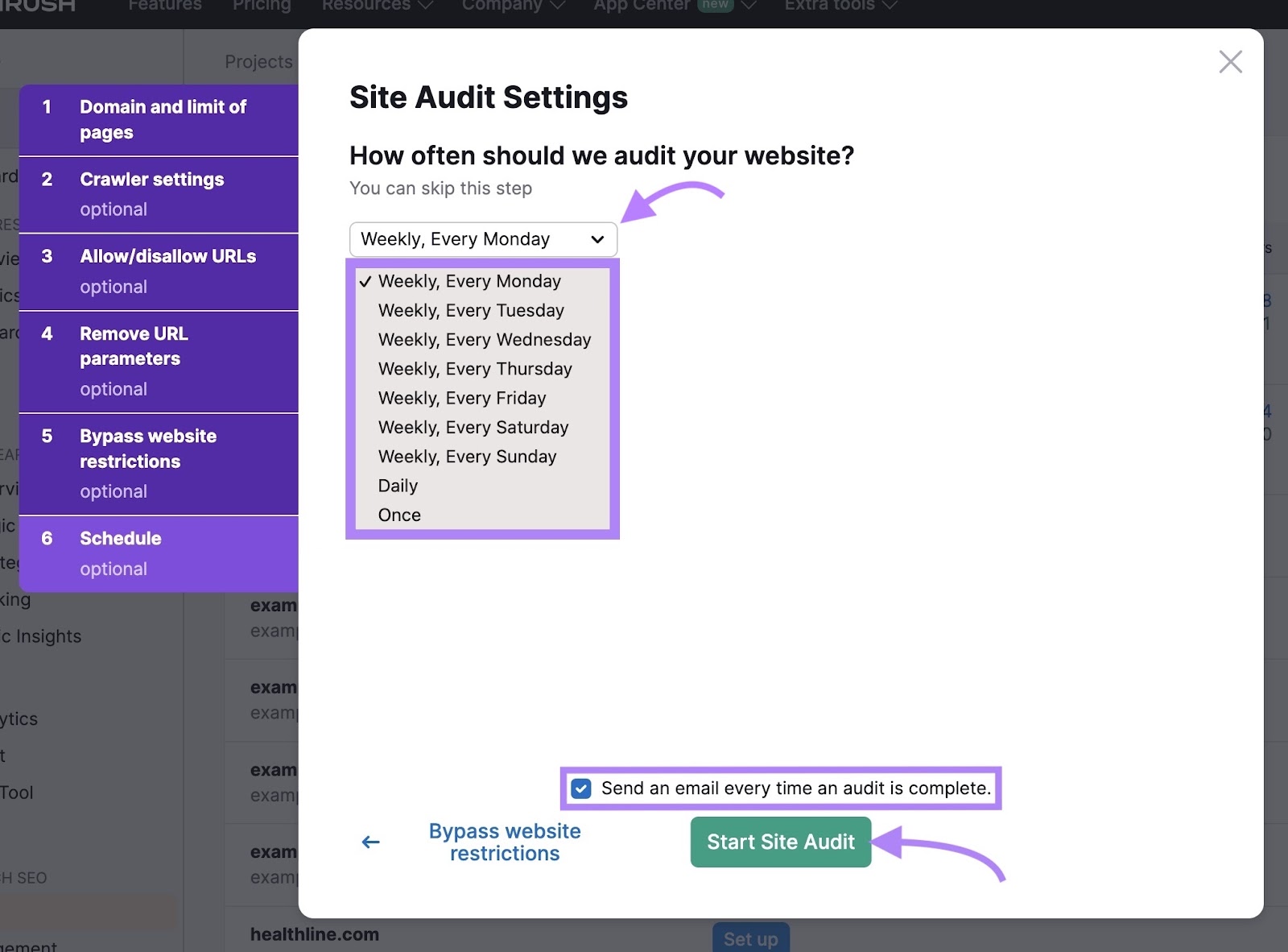
Sign up for a free account immediately to get began.




